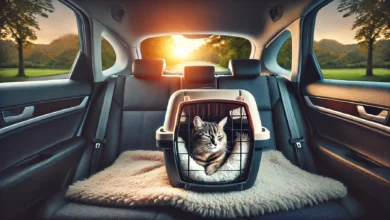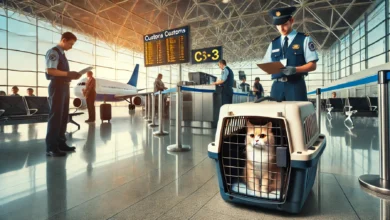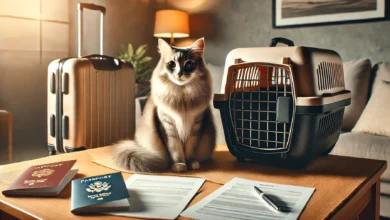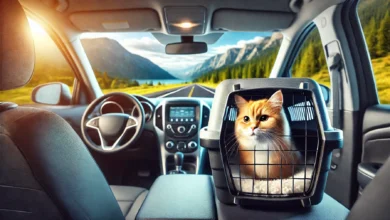How to Manage Feeding Schedules While Traveling with Cats
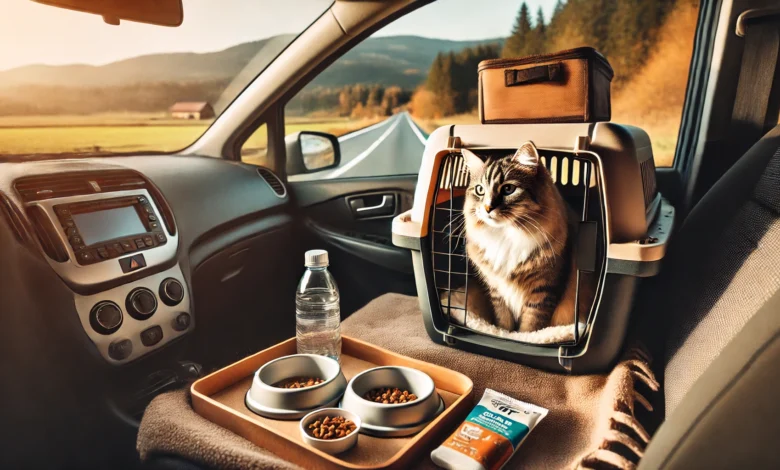
While traveling with your cat can be an excellent adventure, it also poses its special challenges, one important aspect being your cat’s feeding schedule.
Cats are habitual animals, and a little disturbance in their routine can easily cause stress and discomfort.
Ensuring that your cat follows a consistent feeding schedule while on the road is crucial to their health and well-being.
Whether you are on a short or long journey, understanding how to manage the feeding schedule of your cat will make things easier for both you and your feline friend.
In this article, we will explore how to manage your cat’s feeding schedule while traveling.
From understanding your cat’s feeding habits to setting up a travel-friendly meal plan, we’ll cover all the necessary aspects to ensure your cat stays happy and healthy during your trips.
First, let’s discuss how understanding your cat’s feeding routine can impact their overall health while on the road.
Table of Contents
Understanding Your Cat’s Feeding Routine
Your cat’s feeding schedule is not just about timing—it’s an integral part of their overall health.
Cats are creatures of habit and prefer to stick to a specific feeding routine.
Disrupting this schedule can lead to stress, behavioral changes, or even digestive issues.
While it’s important to maintain this routine at home, it becomes even more critical while traveling to avoid any negative impacts on your cat’s health.
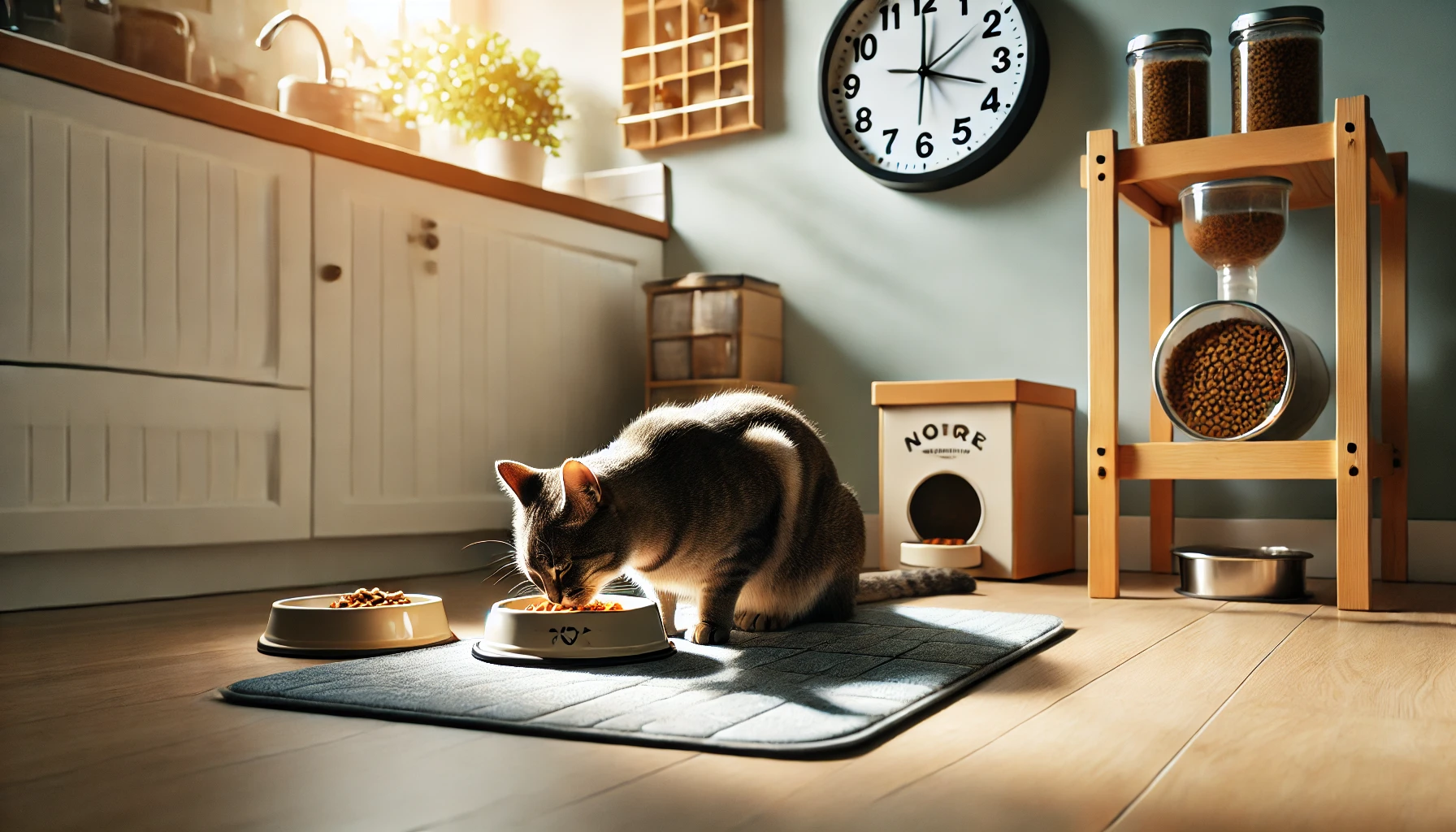
Why a Regular Feeding Schedule is Important
Cats thrive on regularity, and maintaining a consistent feeding schedule provides both physical and emotional stability.
A regular feeding schedule helps to:
- Regulate their bowel movements.
- Prevent underfeeding or overfeeding, which can lead to health complications.
- Reduce stress and anxiety during travel.
- Maintain a healthy body weight and reduce the risk of obesity.
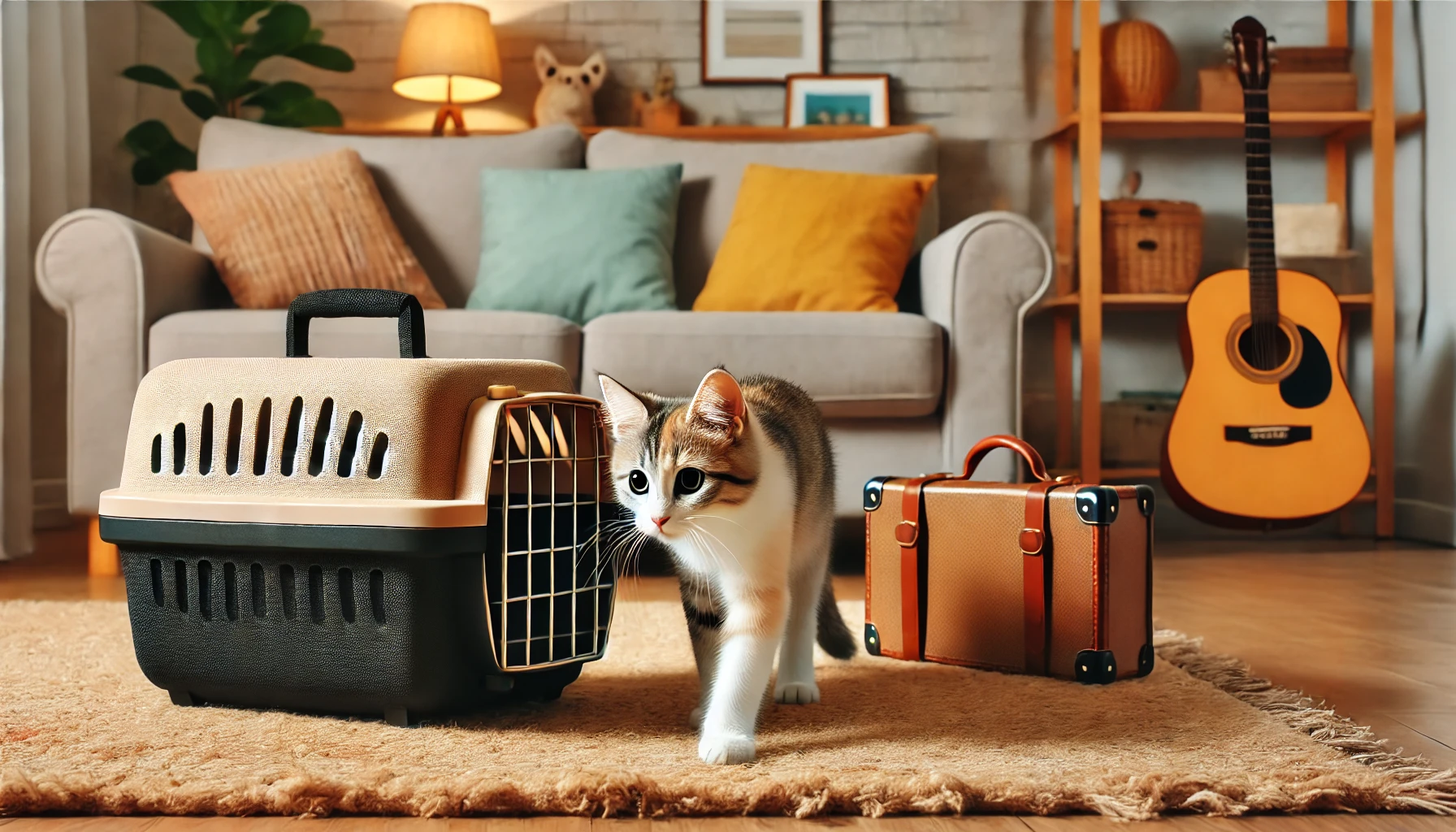
How Cats Adjust to New Environments
Traveling can be a stressful time for cats, as they are exposed to new and unfamiliar environments.
Cats often feel secure in familiar surroundings and rely on their regular feeding schedule to maintain a sense of normalcy.
When this changes, it may take some time for them to adjust.
Some cats may initially refuse to eat, while others may overeat due to stress.
It’s important to be patient and understanding during this adjustment period.
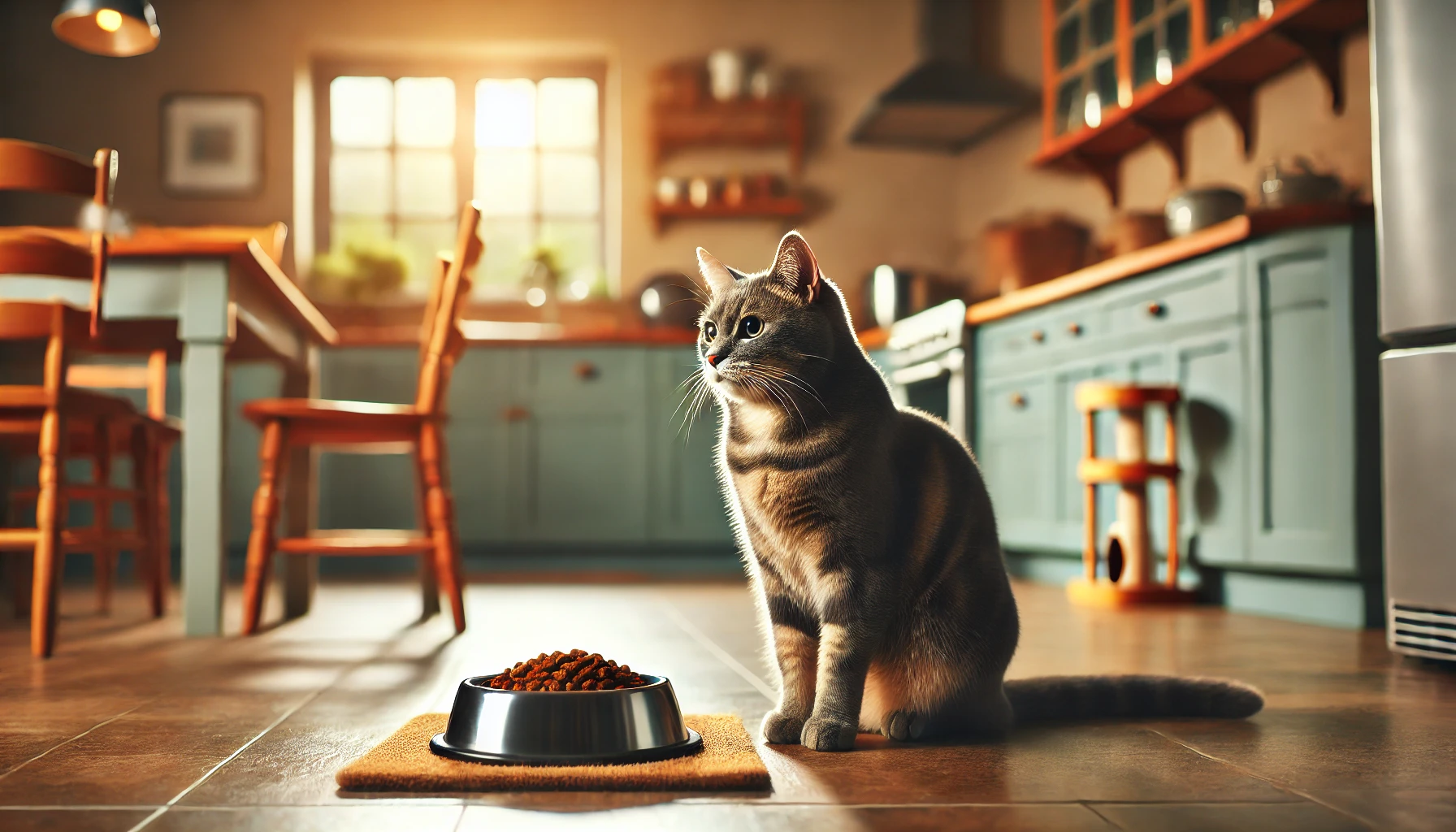
The Importance of Consistent Mealtimes for Your Cat’s Health
Maintaining consistent feeding times while traveling helps regulate your cat’s metabolism, which in turn supports energy levels and digestive health.
Disrupting your cat’s feeding schedule can result in digestive problems like constipation or diarrhea, making travel uncomfortable for your cat.
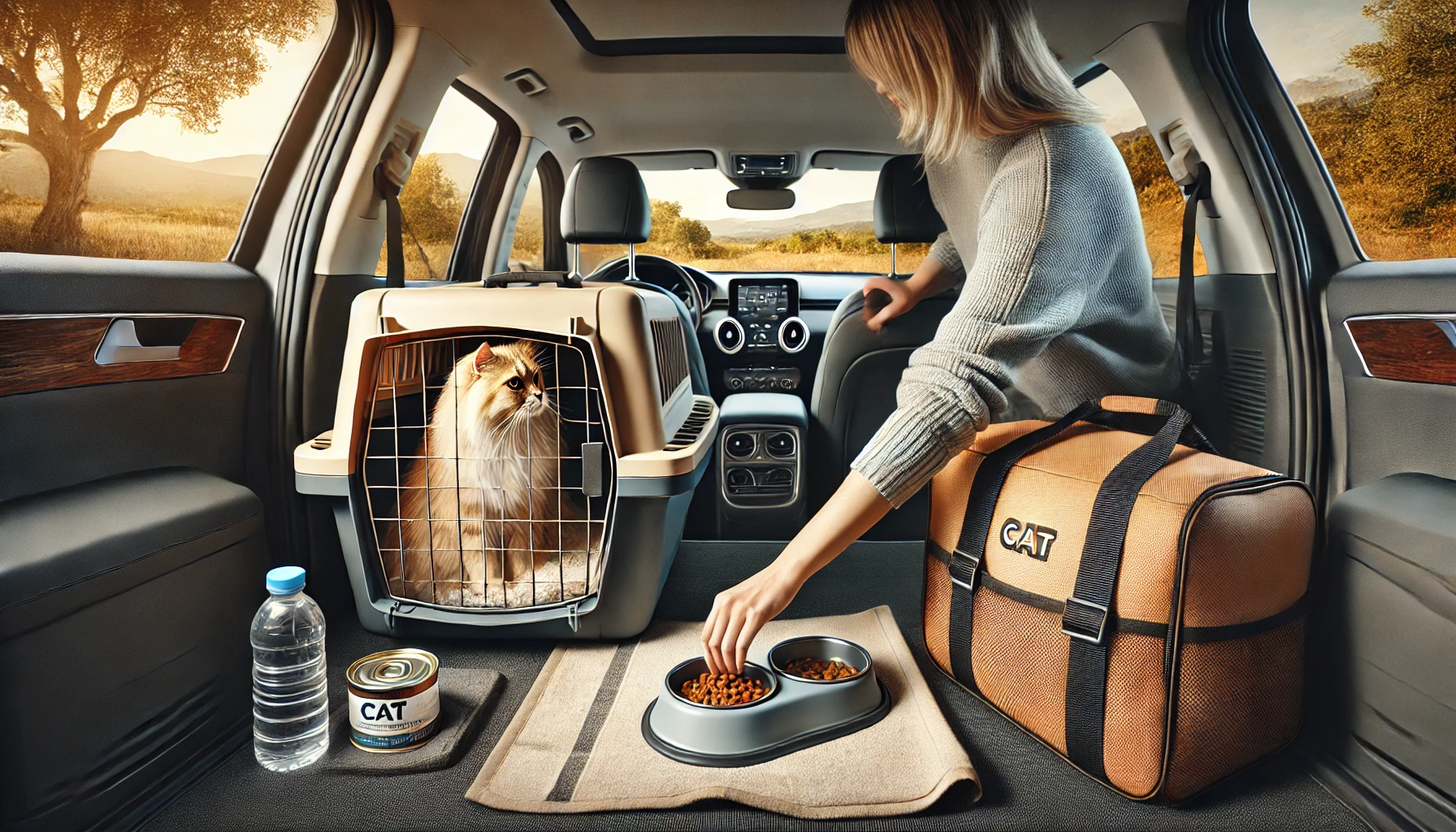
Adjusting Feeding Schedules During Travel
Sometimes, time zones or unpredictable travel schedules can make it difficult to stick to your cat’s exact feeding times.
In such cases, it’s best to gradually adjust your cat’s feeding schedule.
For example, you can shift their feeding time by 30 minutes to an hour before traveling to help them adapt to the new schedule.
This gradual change will minimize the shock of a new routine, ensuring your cat stays comfortable during the journey.
Ensuring your cat’s routine remains unchanged while traveling is crucial to their health. Understanding this can help prevent digestive issues or stress during the trip.
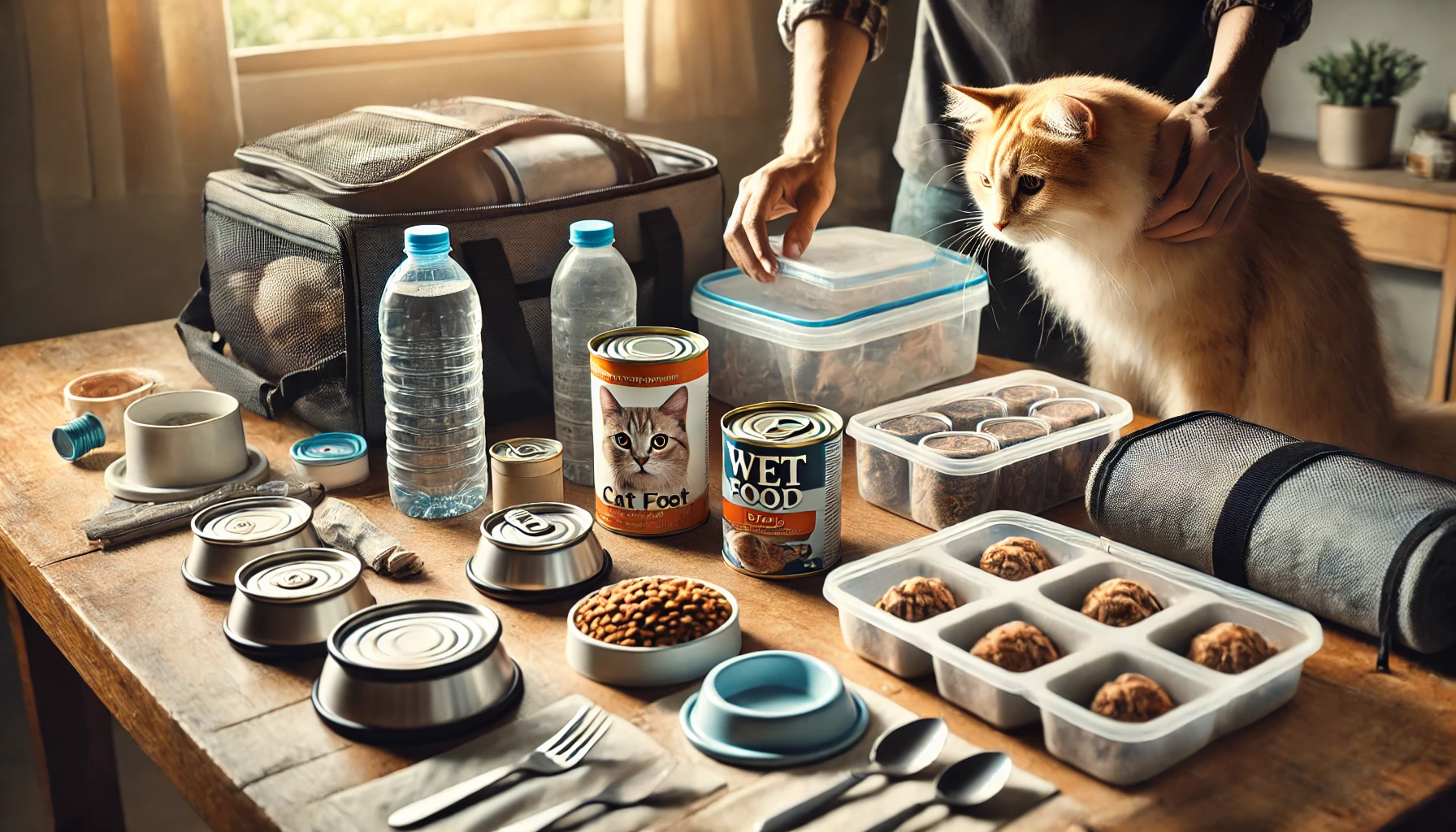
Preparing Your Cat’s Food for Travel
It is equally important to plan for the meals of your cat during the trip, just like ensuring that your cat does not miss their feeding schedule.
When traveling, your cat won’t have access to the usual kitchen setup or the familiar food they are used to.
In that respect, preparation for your cat has to be well thought out to keep them comfortable and well-fed.
Having proper food and storage available will prevent any disruption in their feeding schedule and keep them healthy on the trip.
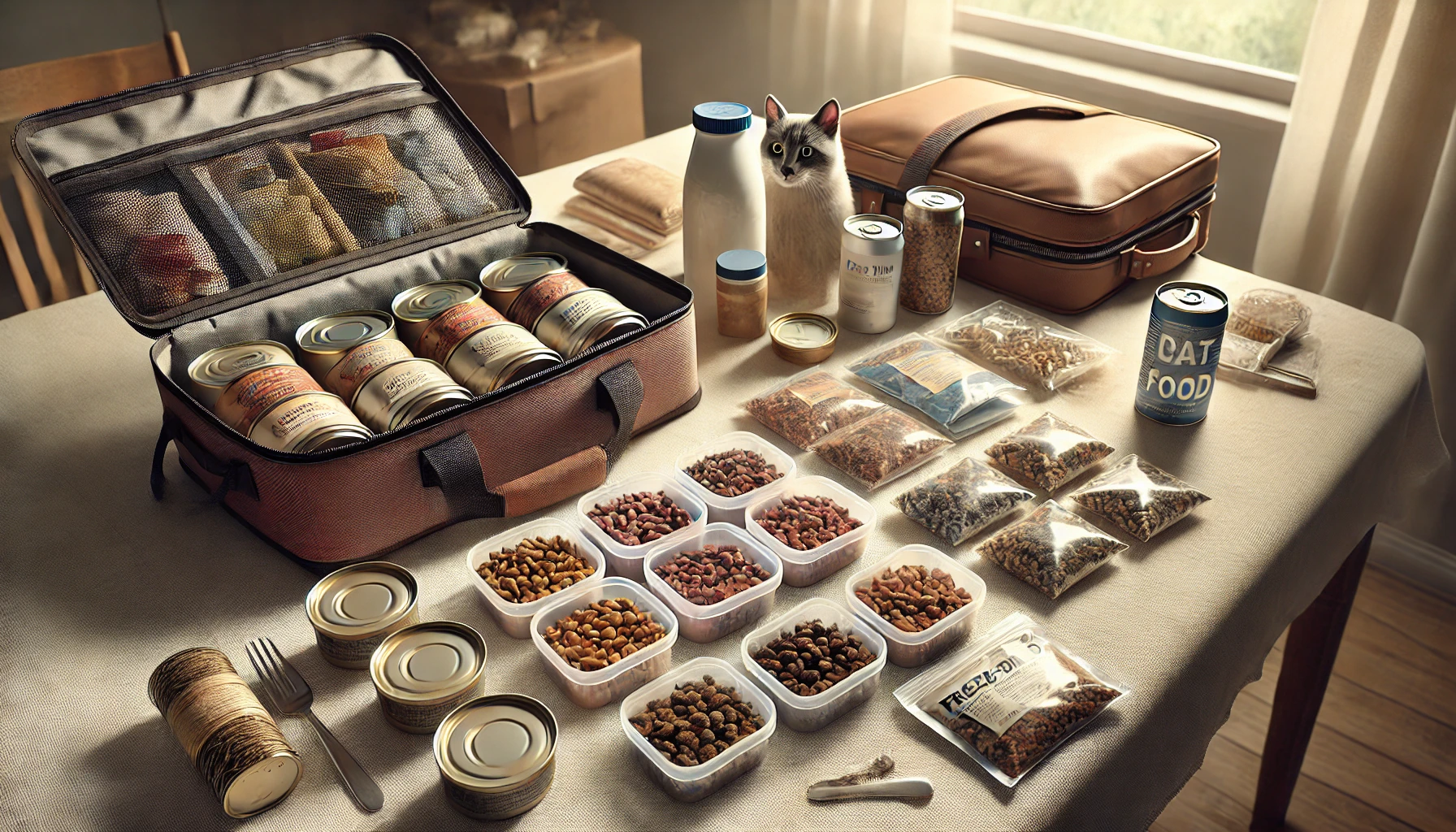
Choosing the Right Type of Cat Food for the Road
When choosing what food to take along for your cat, consider convenience, shelf life, and your cat’s preference.
Dry cat food is always easier to travel with because it doesn’t require refrigeration, and it’s easier to store.
If your cat prefers wet food, consider bringing smaller cans or pouches so that you can offer them a single serving without wasting anything.
Always pack enough for the entire trip, plus a few extra meals, just in case.
For longer trips, you can switch to a combination of wet and dry food for variety, while keeping storage practical.
- Dry food: Convenient to store, suitable for any kind of trip.
- Wet food: Available in single-serving pouches or cans that are easily packed.
- Freeze-dried food: Very light and easy to store; when it’s time to eat, simply add water.
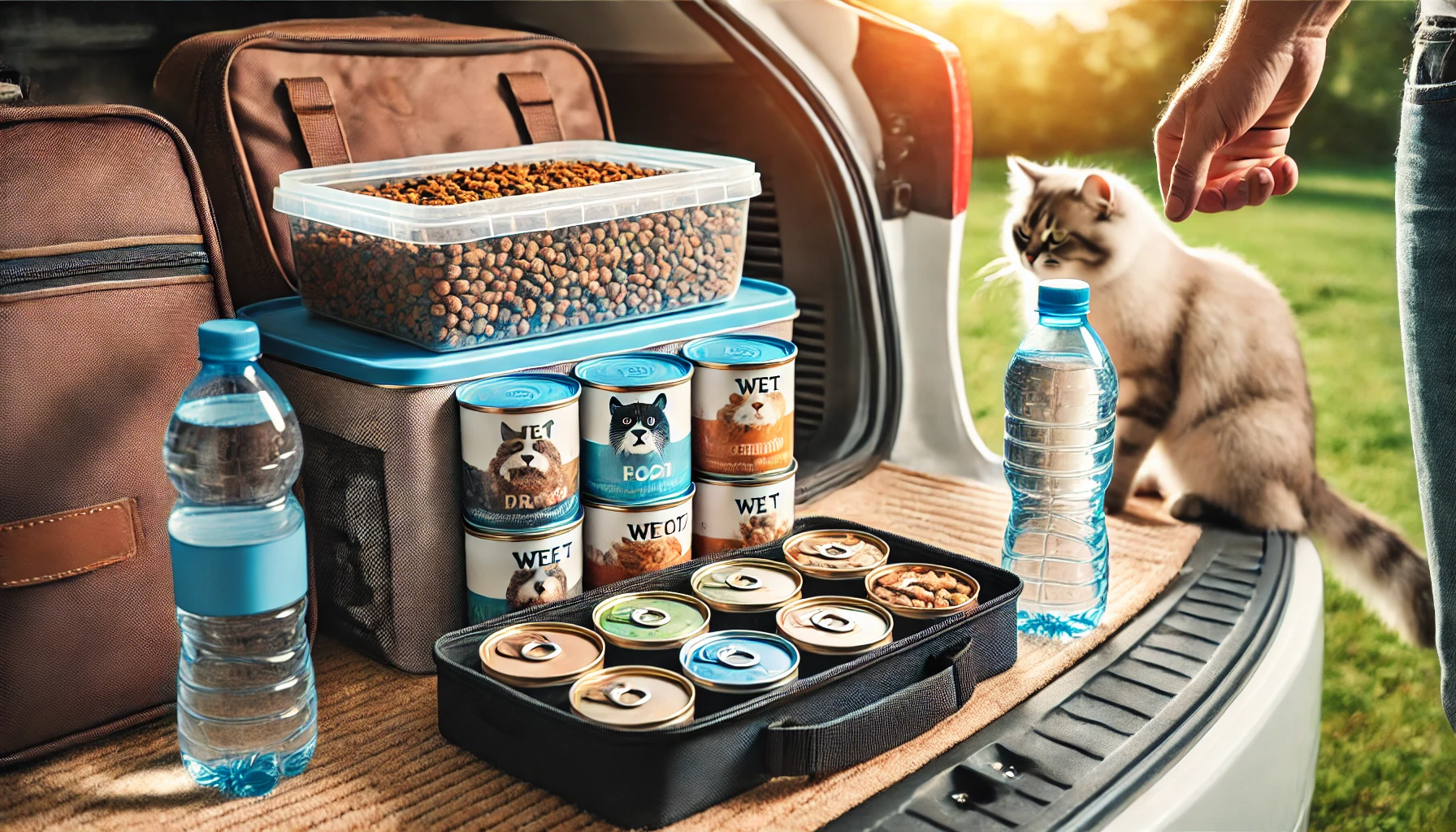
Storing Food Safely While on the Go
Proper storage is essential to keep your cat’s food fresh on the road.
Dry food should be stored in airtight containers to keep out moisture or pests, while wet food needs to be kept cool to avoid spoilage.
If you’re traveling by car, bring a cooler or insulated bag to store wet food.
For air travel, it’s a good idea to check airline regulations regarding the transportation of pet food to ensure compliance.
Also, include feeding bowls, collapsible bowls, or feeding mats to make mealtime easier on the go.
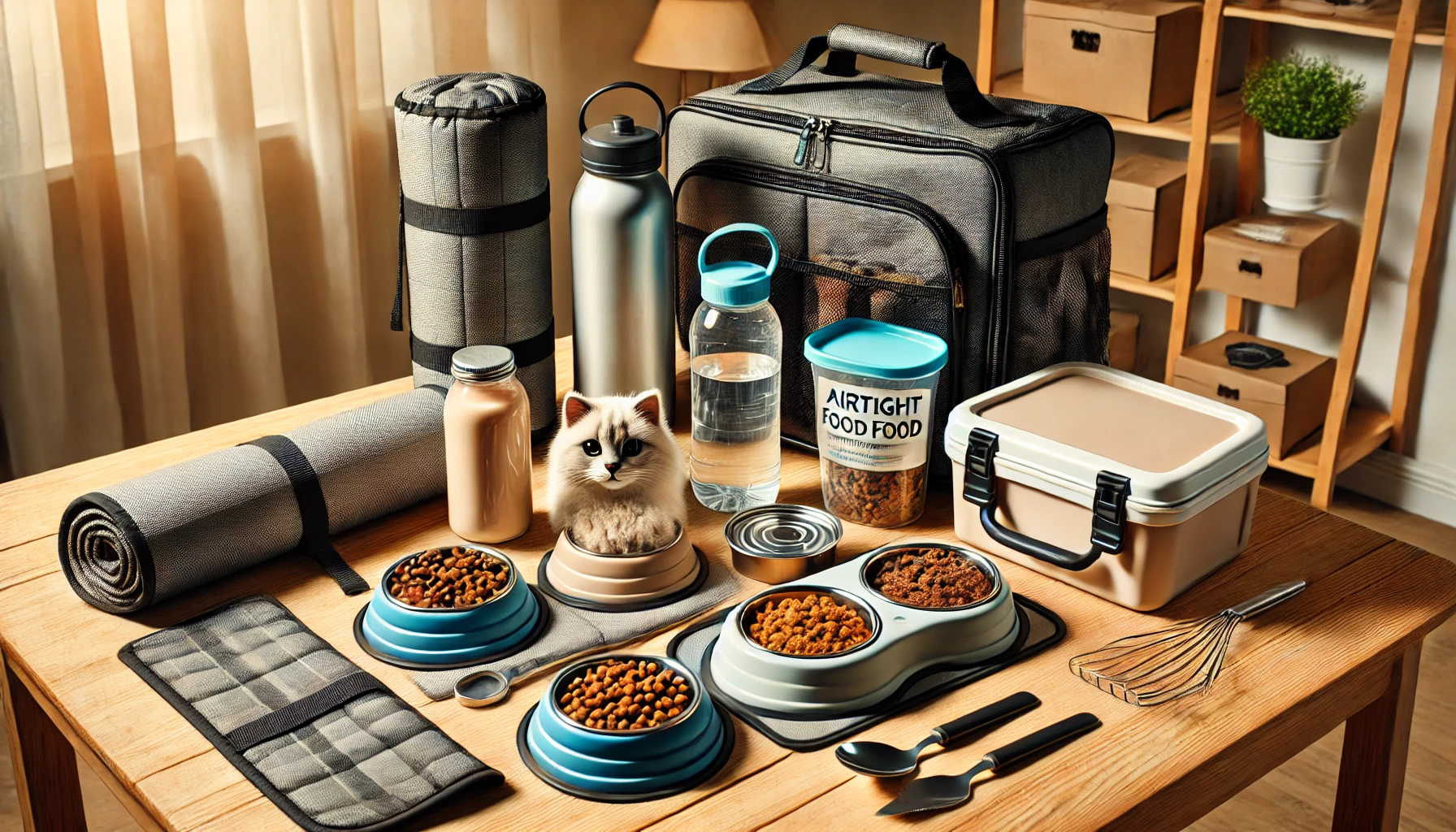
Essentials That Make It Easier to Manage a Cat’s Feeding Schedule
Beyond food, several essentials can help manage your cat’s feeding schedule while traveling.
Collapsible bowls are lightweight and easy to pack, making feeding more convenient.
If your cat has a favorite feeding mat, bringing it along can create a familiar environment, reducing stress.
If your cat is on a special diet, pack enough of their specific food, as finding it on the road may be difficult.
Lastly, bring plenty of fresh water to keep your cat hydrated, especially on longer trips.
- Collapsible Bowls: Lightweight and compact, ideal for feeding on the go.
- Feeding Mat: Provides a familiar environment and is waterproof to protect against spills and accidents.
- Dry Food Storage: Store dry food in an airtight container.
- Wet Food Cooler or Thermal Bag: Necessary for storing wet food during travel.
- Water and Snacks: Plenty of fresh water for your cat to drink.
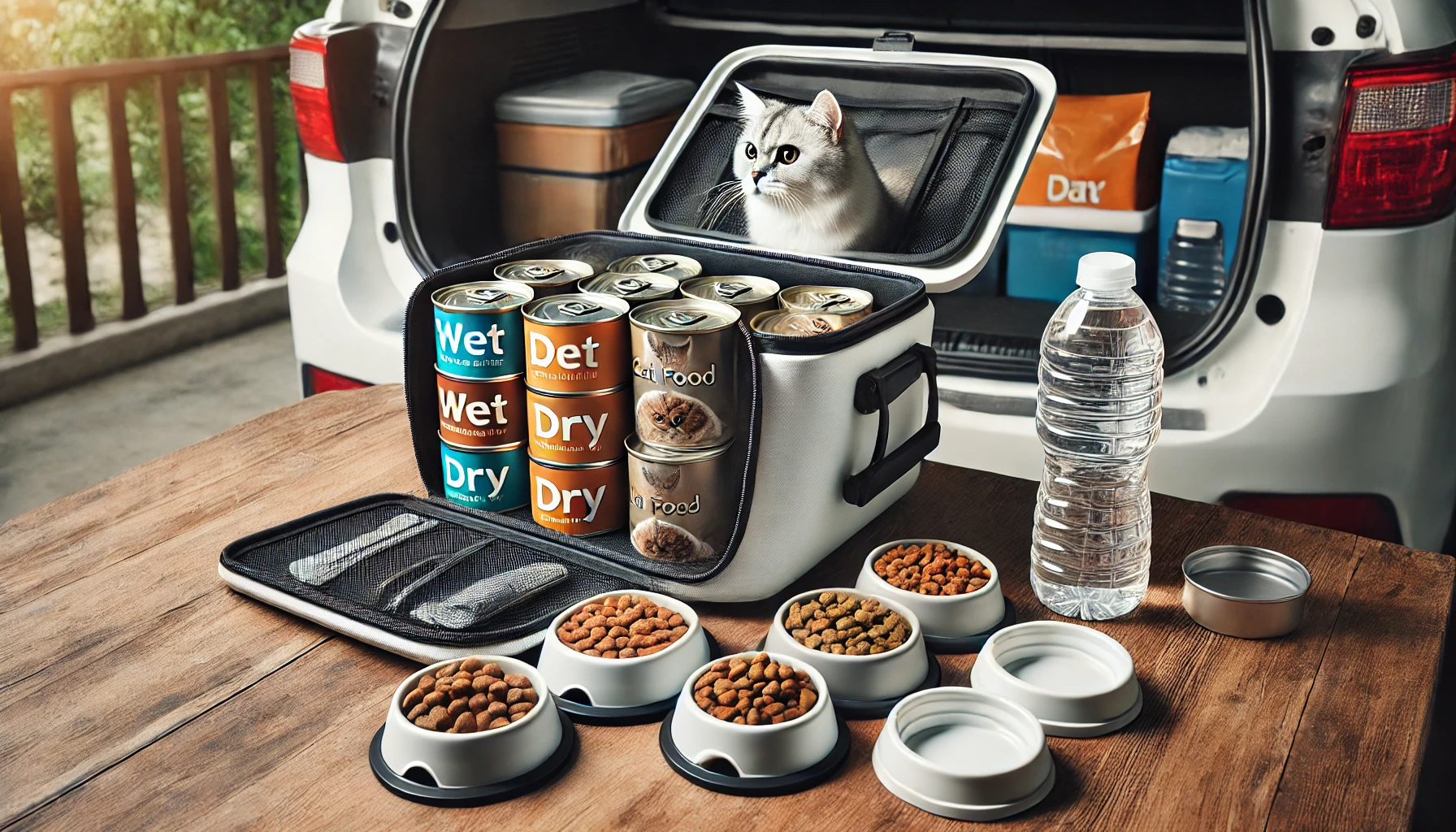
How to Handle Wet vs. Dry Cat Food on the Go
Handling wet and dry cat food on the go can be tricky, but it’s manageable with some planning.
Dry food is easy to pack in lightweight, airtight containers and doesn’t require refrigeration.
Wet food, however, must be kept cool to avoid spoilage.
If you prefer feeding wet food, plan to bring small cans or pouches and a cooler for proper storage.
Some cats enjoy a combination of wet and dry food, so consider how to balance their diet while keeping convenience in mind for storage and travel.
Preparation is key. Make sure to pack enough food and store it properly to ensure your cat stays nourished during the journey.
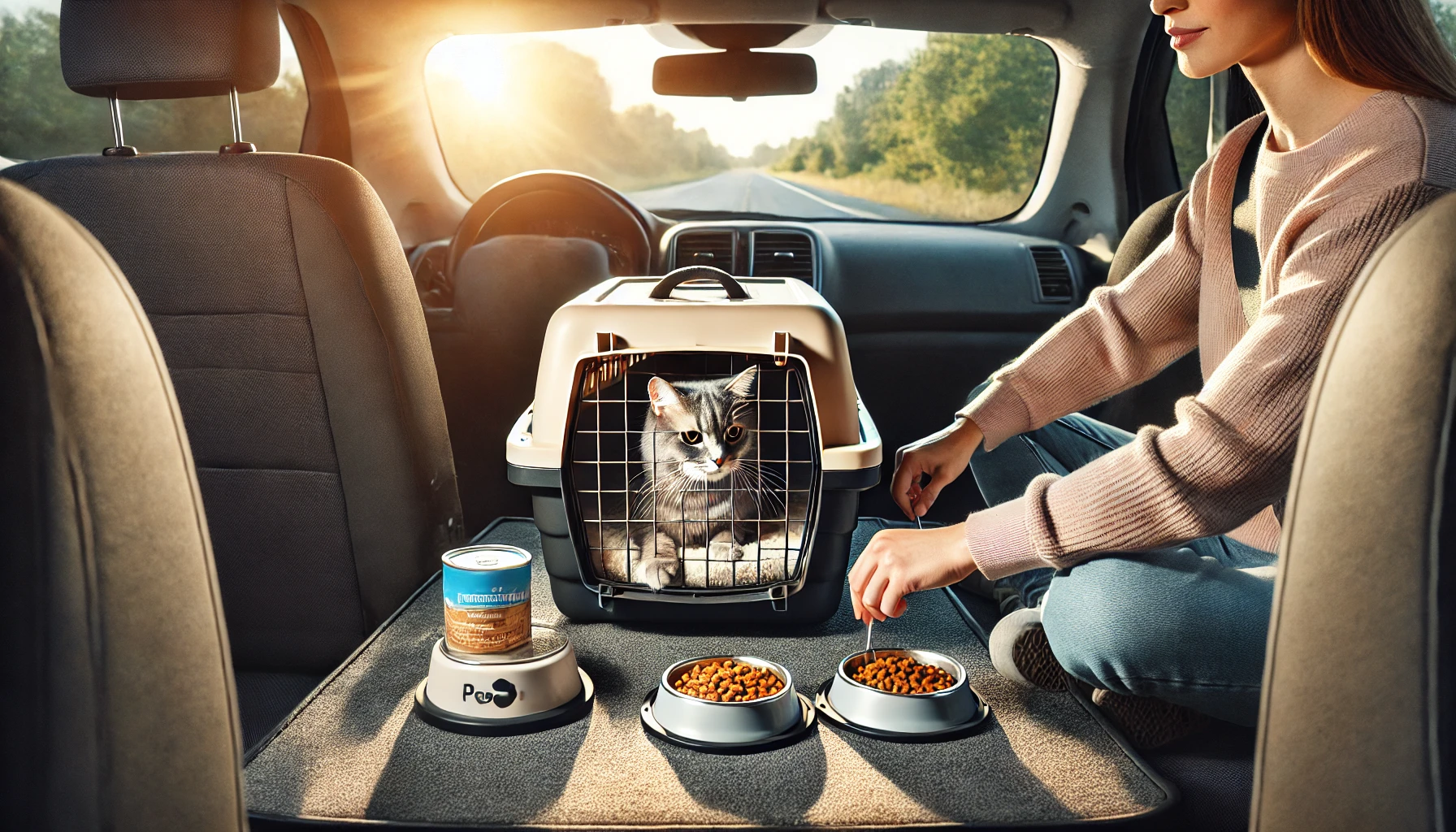
Establishing a Travel-Friendly Feeding Schedule
Sticking to a regular feeding schedule while traveling can indeed be challenging, but it helps to keep your cat comfortable and healthy.
An effective travel-friendly feeding schedule takes into account time zone changes, trip duration, and your cat’s adaptability to these changes.
By planning ahead, you can ensure that your cat sticks to a routine that works for both of you, preventing disruptions to their feeding habits and overall health.
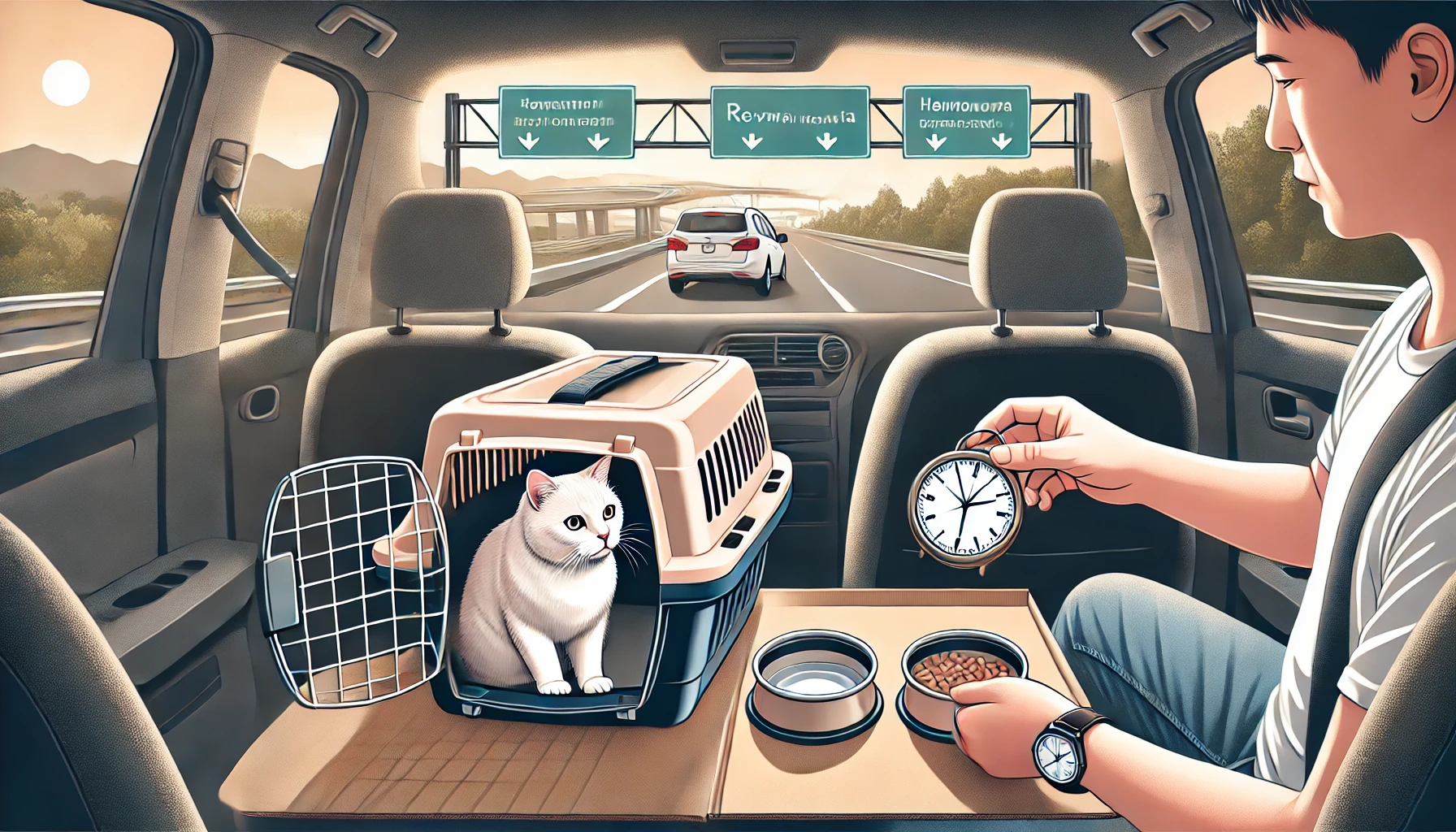
Keeping Feeding Times Consistent Across Time Zones
If you’re crossing over time zones, this could affect your feeding schedule.
To help your cat stay comfortable, you should gradually adjust their feeding times over several days before embarking on your trip.
Shift meals 15-30 minutes earlier or later each day until they align with the time zone you are traveling to.
This gradual change makes it easier for your cat to adjust to the new feeding schedule, minimizing stress or discomfort.
During the trip, try to adhere as closely as possible to the adjusted feeding times.
While the time zones may differ, maintaining consistent mealtimes will help your cat feel more secure in unfamiliar surroundings.
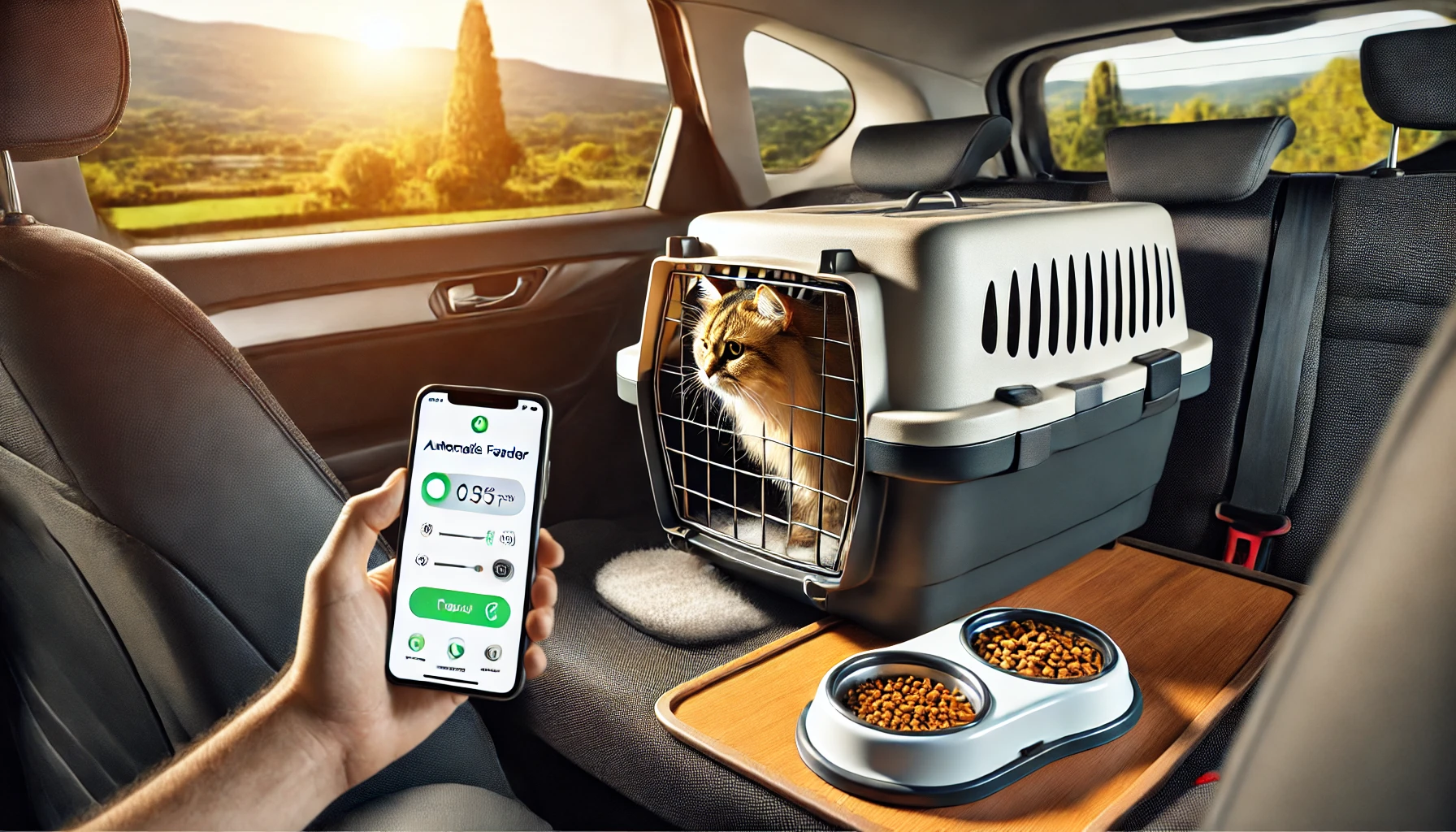
Using Automatic Feeders and Smart Gadgets on the Road
Technology can be a lifesaver in maintaining feeding schedules during travel.
Automatic feeders allow you to set specific feeding times, ensuring your cat is fed even if you’re busy or on the move.
These feeders are especially helpful during long trips when sticking to a set schedule might be difficult.
Advanced features like portion control, voice recordings to call your cat to eat, and smartphone integration allow you to remotely monitor and schedule feedings.
This reduces the stress of managing your cat’s feeding schedule while ensuring they don’t miss a meal.
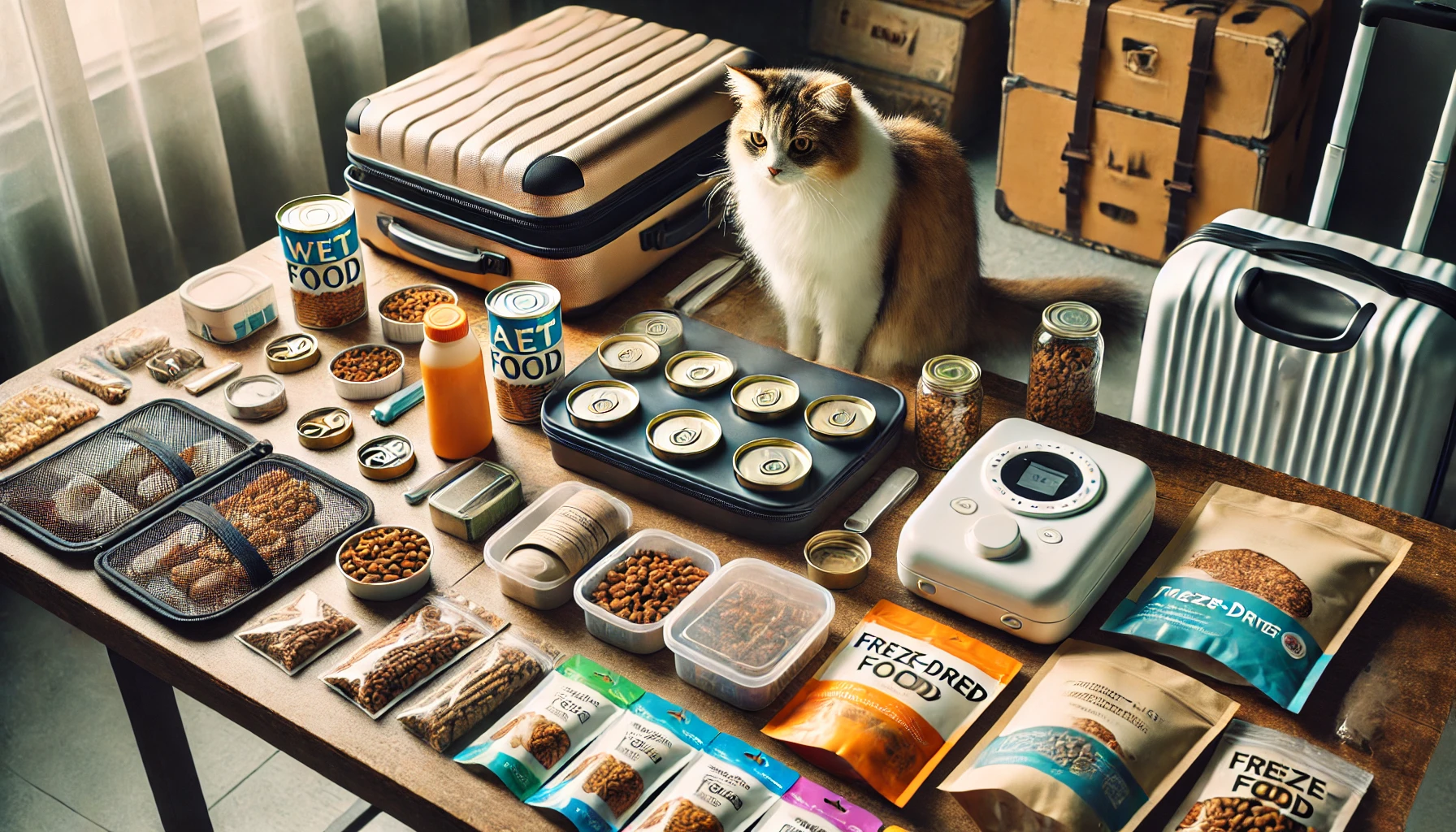
Travel-Friendly Feeding Options: Pros and Cons
There are several travel-friendly feeding options, each with its pros and cons.
Depending on your cat’s preferences and the nature of your trip, you can choose what works best for both of you:
- Pre-packaged single-serving wet food: Convenient for short trips but requires refrigeration for longer journeys.
- Dry food in airtight containers: Convenient for storage and doesn’t require refrigeration, but may not be suitable for cats that prefer wet food.
- Automatic feeders: Ideal for longer trips and helps manage busy schedules. However, they require power and setup.
- Freeze-dried food: Lightweight and easy to store, but requires water and may take time for your cat to adjust to.
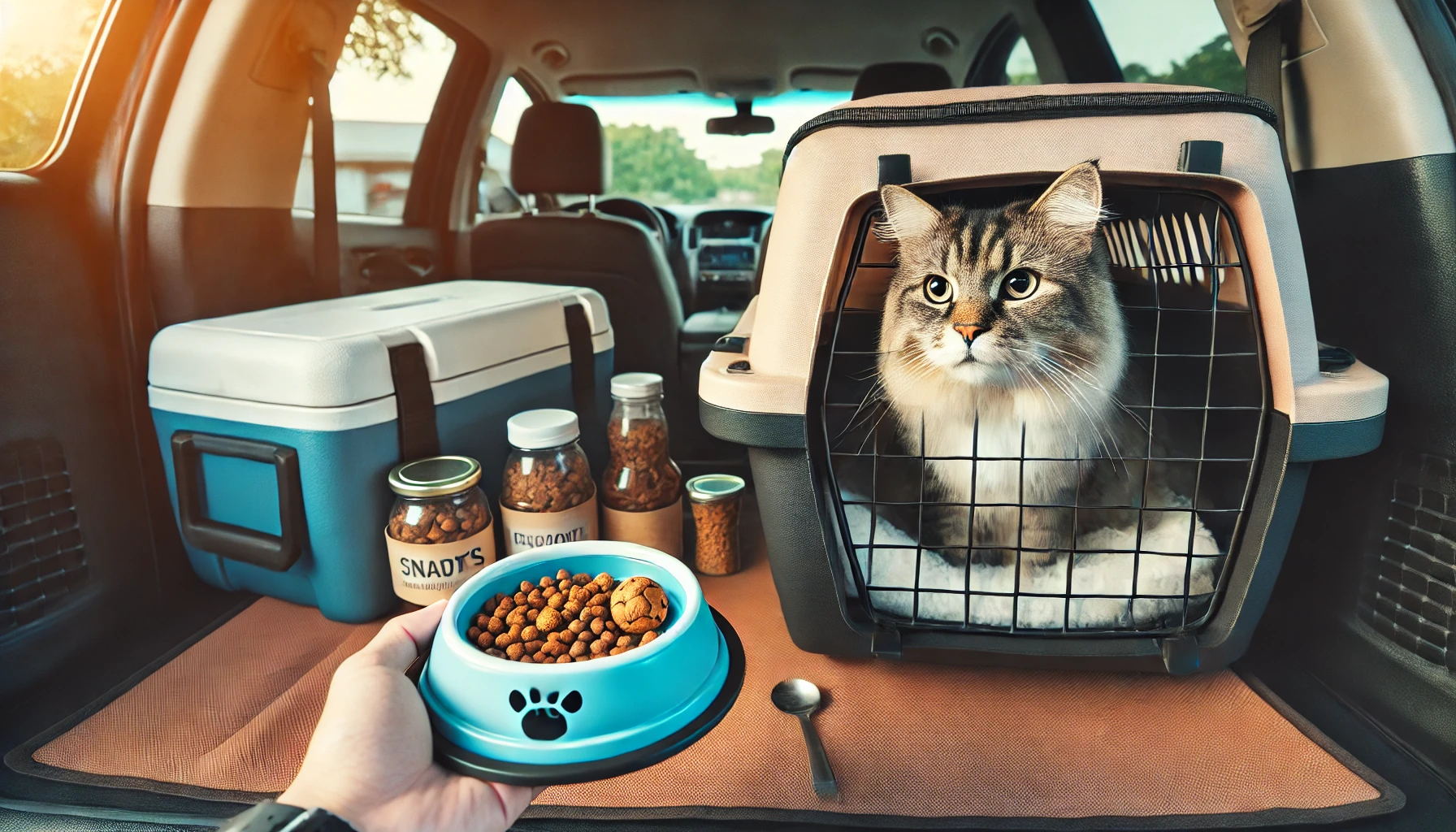
How to Handle Delays and Missed Meals
Delays are common when traveling, and mealtimes can sometimes be disrupted.
If your cat misses a meal due to unforeseen circumstances, don’t worry.
Cats can safely go a little longer without food, but it’s important to get them back on schedule as soon as possible.
If a delay leads to a missed meal, continue with the next scheduled feeding without doubling up the portion, as this could lead to overeating.
Consider bringing some easy-to-pack snacks or treats in case of delays.
Having a few extra options can help tide your cat over until their next meal.
Adjust your cat’s feeding schedule gradually to fit new time zones, ensuring minimal disruption to their routine.
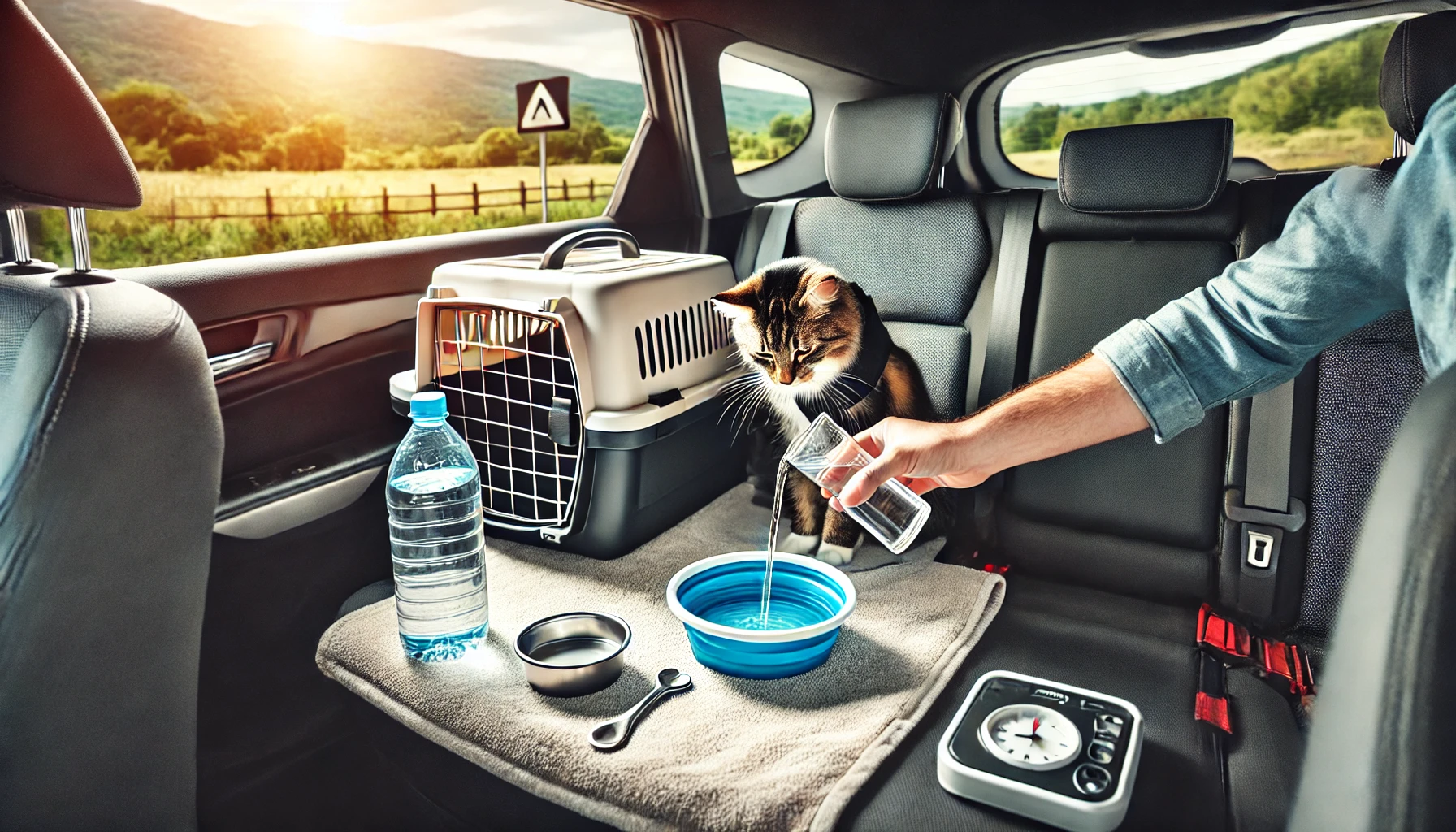
Managing Your Cat’s Hydration During Travel
Keeping your cat hydrated on a trip is as important as maintaining their feeding schedule.
Cats can be finicky with their water, and a change of environment might make them reluctant to drink.
Ensuring that your cat stays well-hydrated throughout the journey can prevent potential health issues, such as urinary tract infections or dehydration, which can be hazardous for your feline friend.
Let’s explore how to keep your cat hydrated on the road.
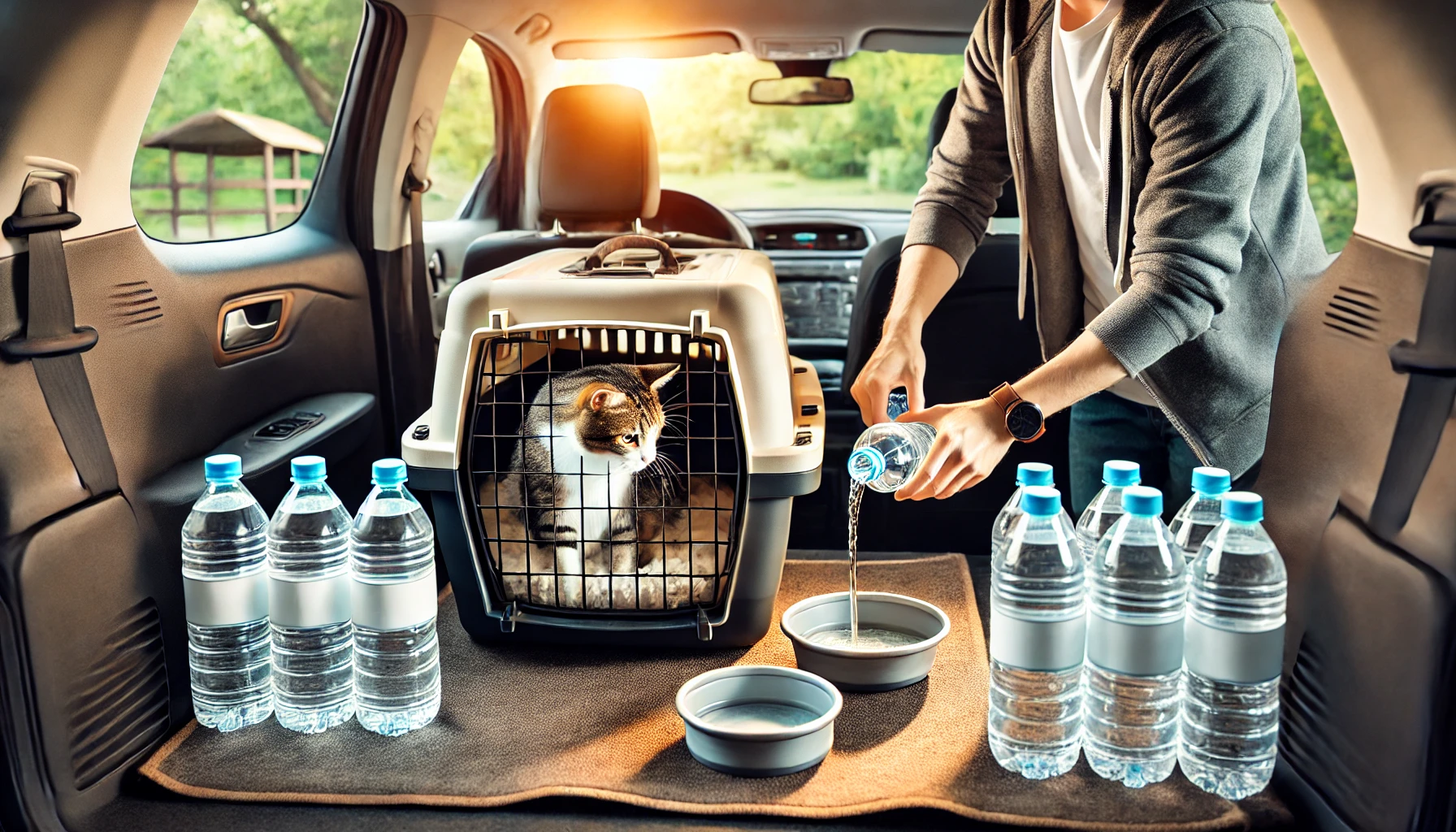
Ensuring Fresh Water Supply While Traveling
When traveling with your cat, always take an adequate amount of fresh water from home.
Cats can be very picky about the taste of water, and they might refuse to drink if the water tastes different due to variations in mineral content.
By bringing water that your cat is accustomed to, you reduce the chances of refusal to drink.
Pack enough water for the entire trip and make sure it is accessible at all times.
If you’re traveling by car, bring water in a leak-proof container to avoid messes.
Collapsible water bowls or portable dispensers make it easy for your cat to drink on the go.
If you’re flying, check with your airline to see if there are any restrictions on bringing liquids for your pet.
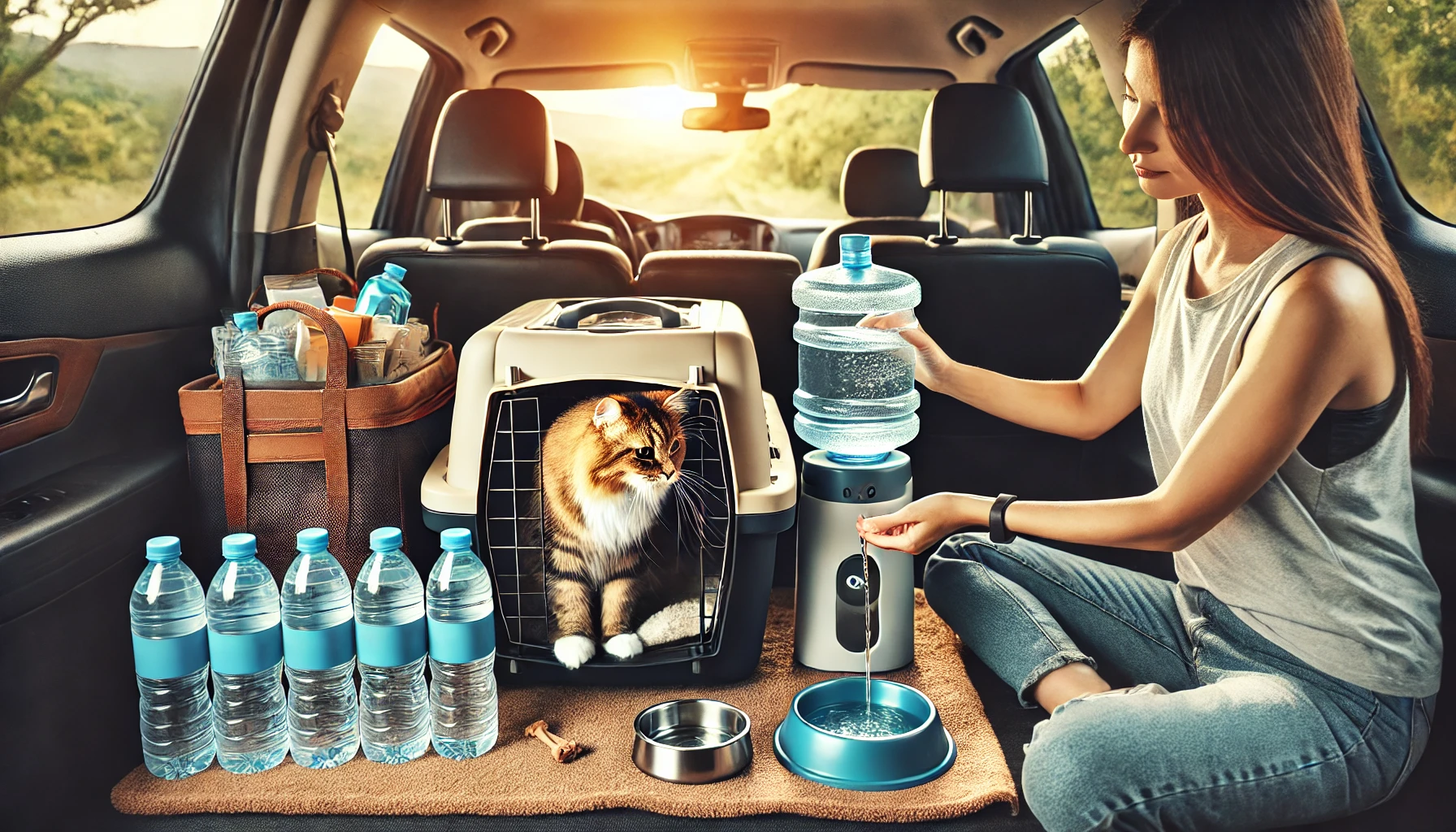
How to Keep Your Cat Hydrated on Long Trips
Your cat is more likely to become dehydrated during long trips.
Cats usually get much of their moisture from food, so if they are eating dry food while traveling, they will need extra water.
Encourage your cat to drink by offering water at regular intervals.
Try giving small amounts of water every couple of hours instead of a full bowl at once to avoid overwhelming your cat.
You can also mix a small amount of water into their wet food, if your cat tolerates it.
This will help increase their fluid intake without requiring them to drink from the bowl.
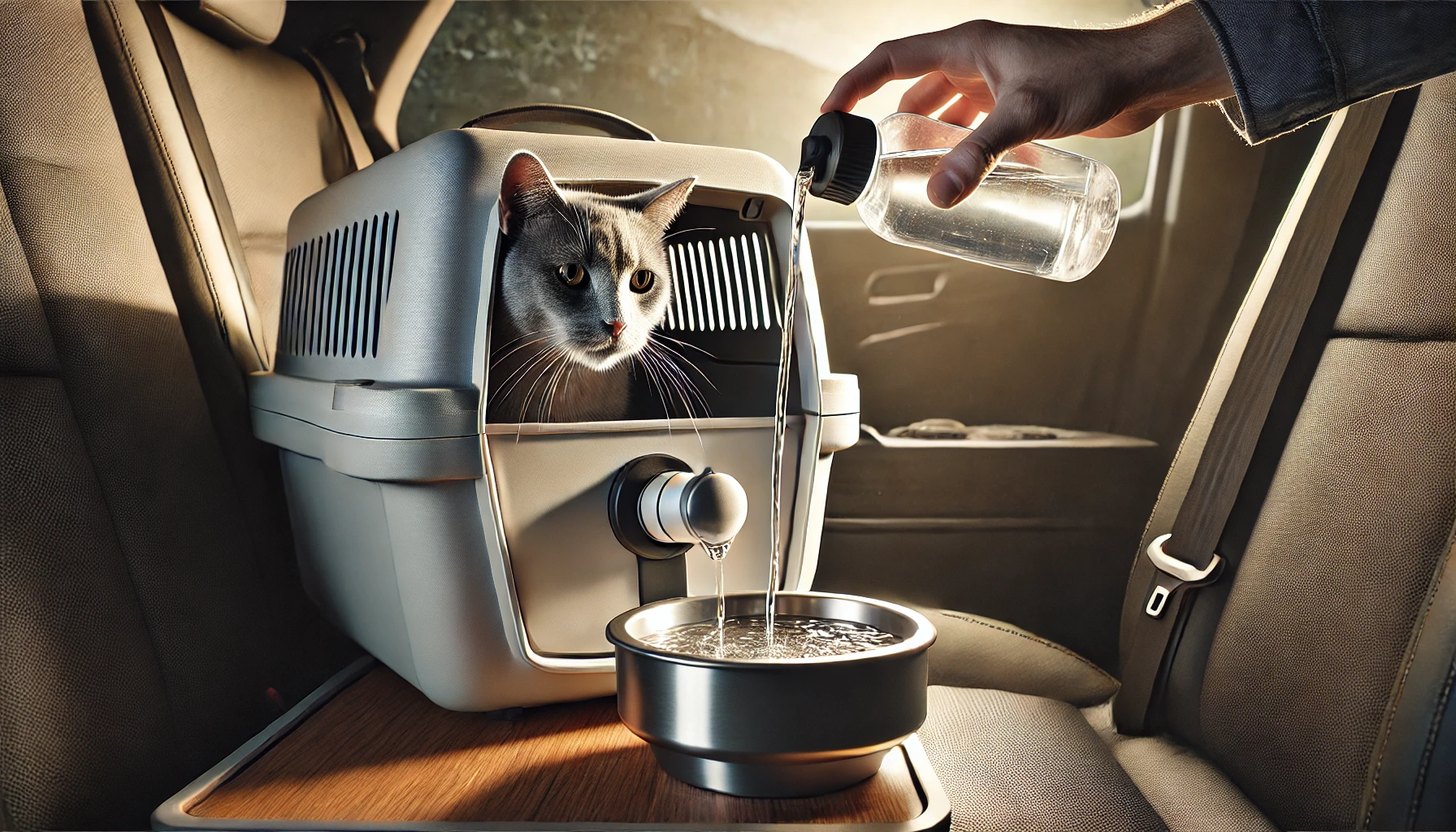
Portable Water Dispensers for Cats
Portable water dispensers designed for pets are a lifesaver during travel.
They are lightweight, easy to carry, and provide a quick, efficient way to offer water to your cat.
Many dispensers come with a built-in bowl, allowing you to pour water easily without needing additional accessories.
Look for leak-proof models to avoid spills in your travel bag.
These dispensers are compact and ideal for long journeys as well as short outdoor trips.
Some even come with built-in filtration systems, ensuring your cat gets fresh and clean water every time.
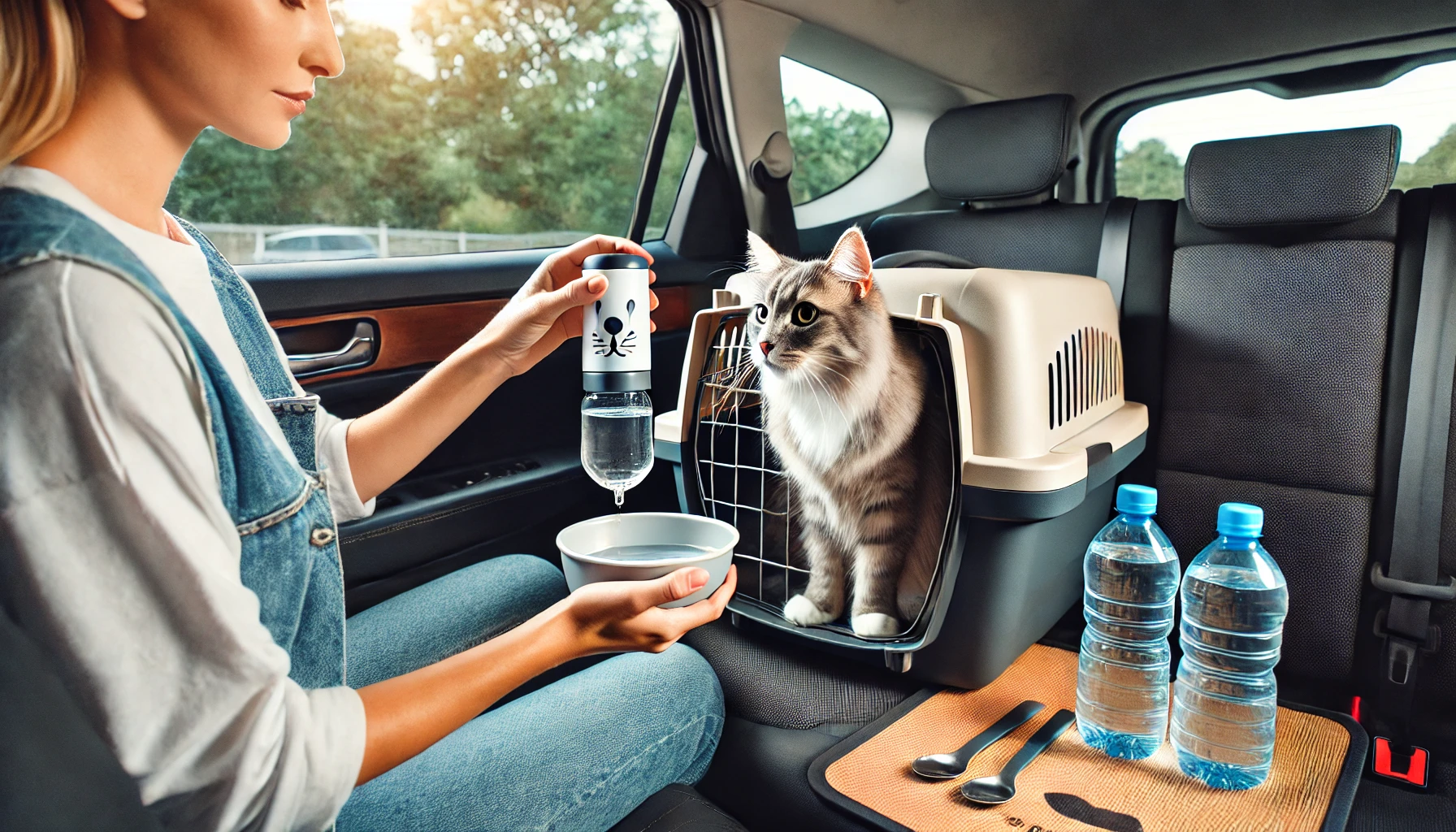
Tips to Encourage Cats to Drink Water While Traveling
Getting your cat to drink water while traveling can be tricky, as stress from the journey may reduce their willingness to drink.
Here are a few tips to help keep your cat hydrated:
- Offer water frequently: Present water at regular intervals, especially during long drives.
- Use familiar bowls: Bring your cat’s usual water bowl to create a sense of familiarity.
- Flavor the water: If your cat refuses to drink, mix a small amount of tuna juice or low-sodium chicken broth into the water to make it more appealing.
- Provide a calm environment: Stress may reduce your cat’s desire to drink, so try to minimize noise and activity during the trip.
By following these tips, you can help your cat stay hydrated and comfortable during travel.
Always bring fresh water from home to keep your cat hydrated, especially when traveling long distances. Hydration is just as important as feeding.
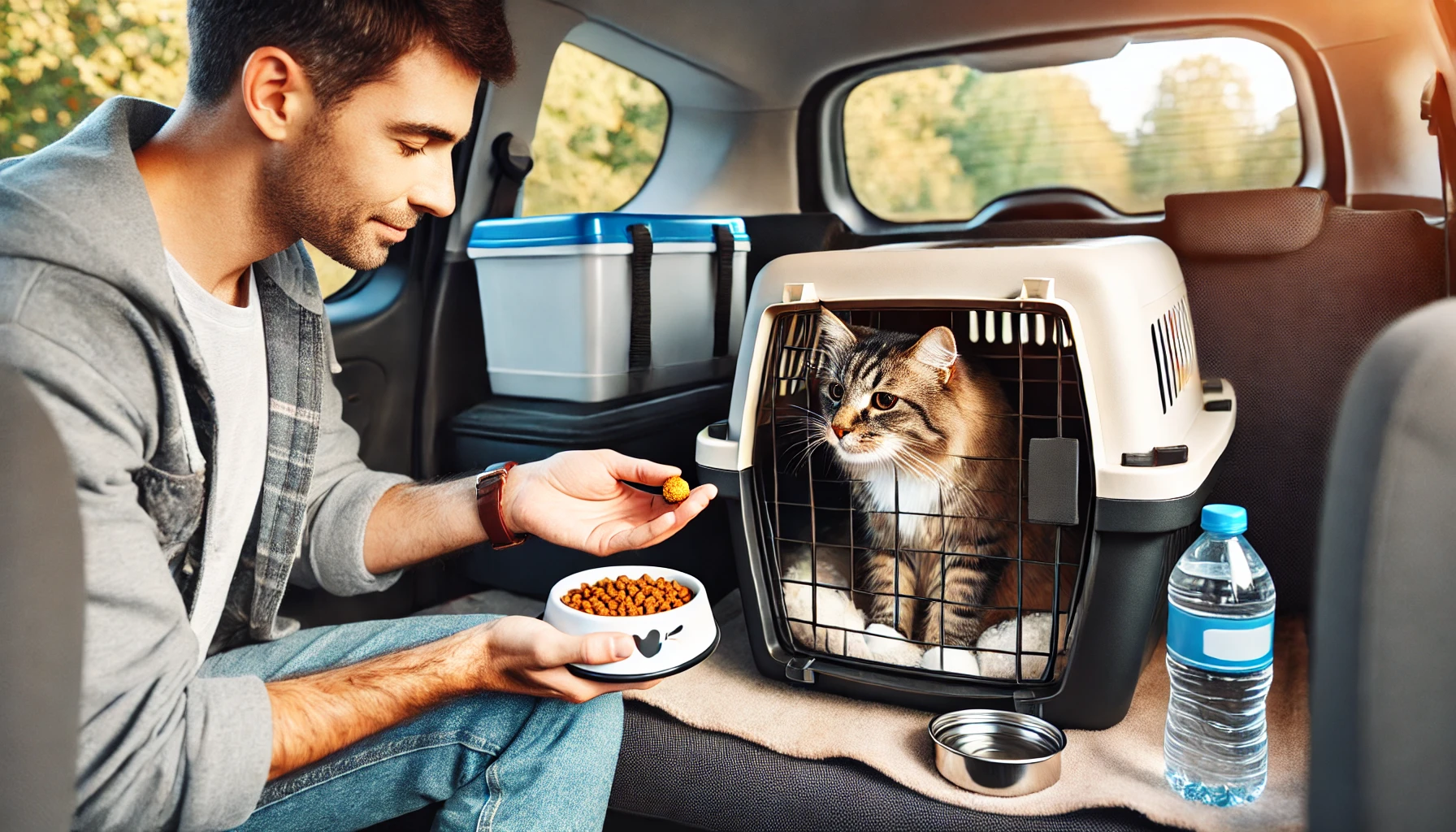
Coping with Feeding Problems While on the Go
Some of the challenges you face when feeding your cat on the road can be quite different, especially if your cat is a picky eater or has specific dietary needs.
Travel can disrupt routines, making it difficult to stick to a regular feeding schedule, and some cats might refuse to eat due to the stress of new environments.
Fortunately, with the right strategies, you can overcome these challenges and keep your pet nourished and healthy during the journey.
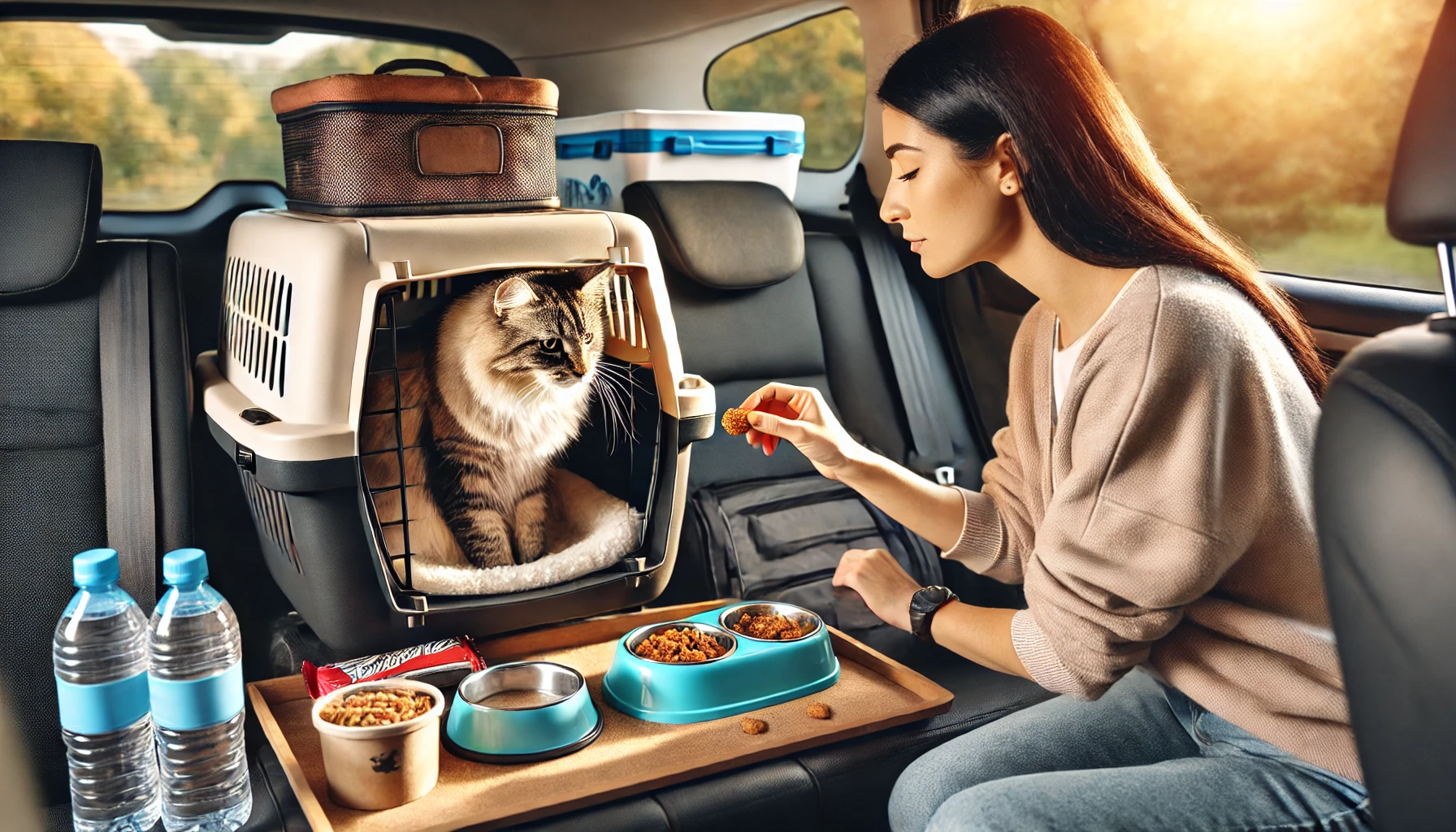
Dealing with Picky Eaters While Traveling
Travel can make picky cats even more finicky.
Cats often resist changes in their food, and travel is not the best time to introduce new brands or types of food.
Stick with your cat’s preferred food to minimize the chances of them refusing to eat.
Warming up wet food slightly can make meals more appealing and encourage your cat to eat.
It’s also helpful to bring familiar feeding items, like their regular bowl, to provide comfort and reduce their stress.
If your cat refuses to eat during the first day or two of the trip, don’t be alarmed—this is a common reaction to the stress of being in a new environment.
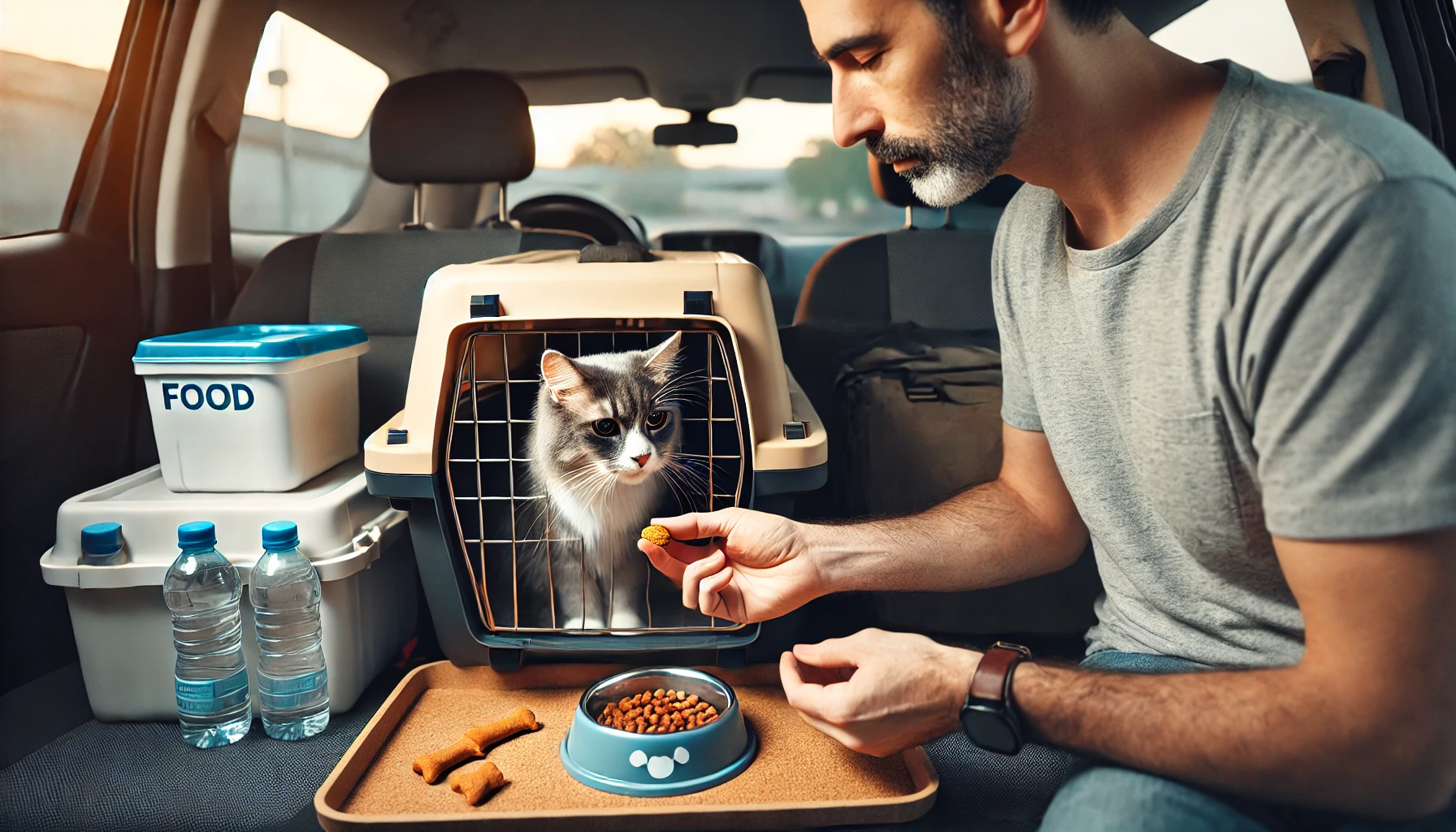
What to Do if Your Cat Refuses to Eat
It’s not unusual for cats to stop eating when they’re stressed.
If your cat refuses food while traveling, offer smaller portions more frequently.
Sometimes, you may need to coax them by offering food by hand or adding a small amount of a favorite treat or something strong-smelling, like tuna juice, to entice them.
If your cat still refuses to eat after 24-48 hours, it’s time to consult a veterinarian.
Prolonged periods without food can lead to hepatic lipidosis (fatty liver disease), which is potentially fatal, especially for overweight cats.
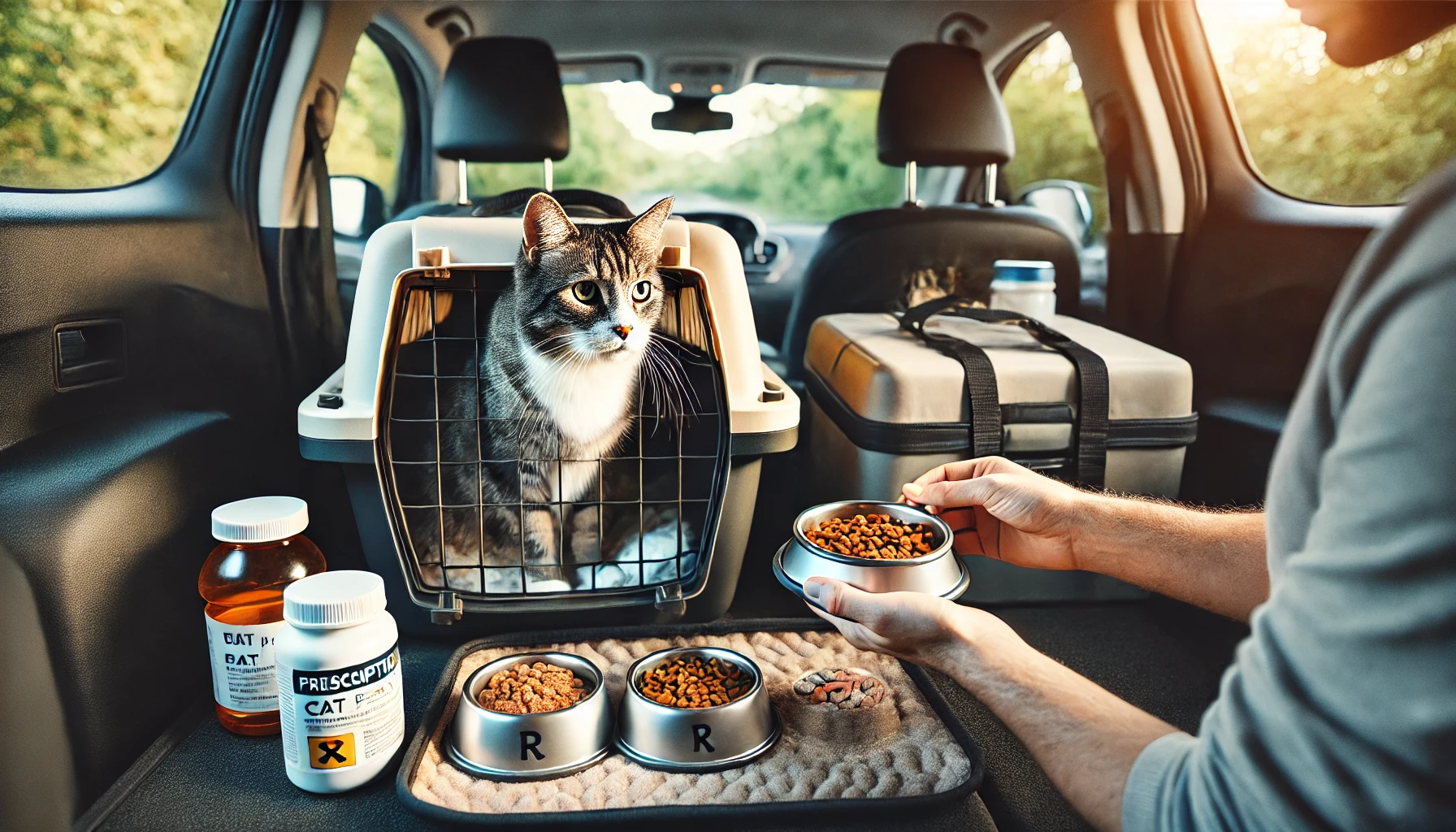
Feeding Tips for Cats with Special Dietary Needs
Cats with special diets require extra attention while traveling.
Whether your cat is on a prescription diet or has specific food needs due to allergies, pack enough of their specialized food for the entire trip, as finding the right food on the road can be difficult.
It’s a good idea to carry a copy of your cat’s dietary information or prescription in case you need to visit a vet while traveling.
Don’t forget to pack any supplements or medications that are part of their routine to keep them healthy throughout the journey.
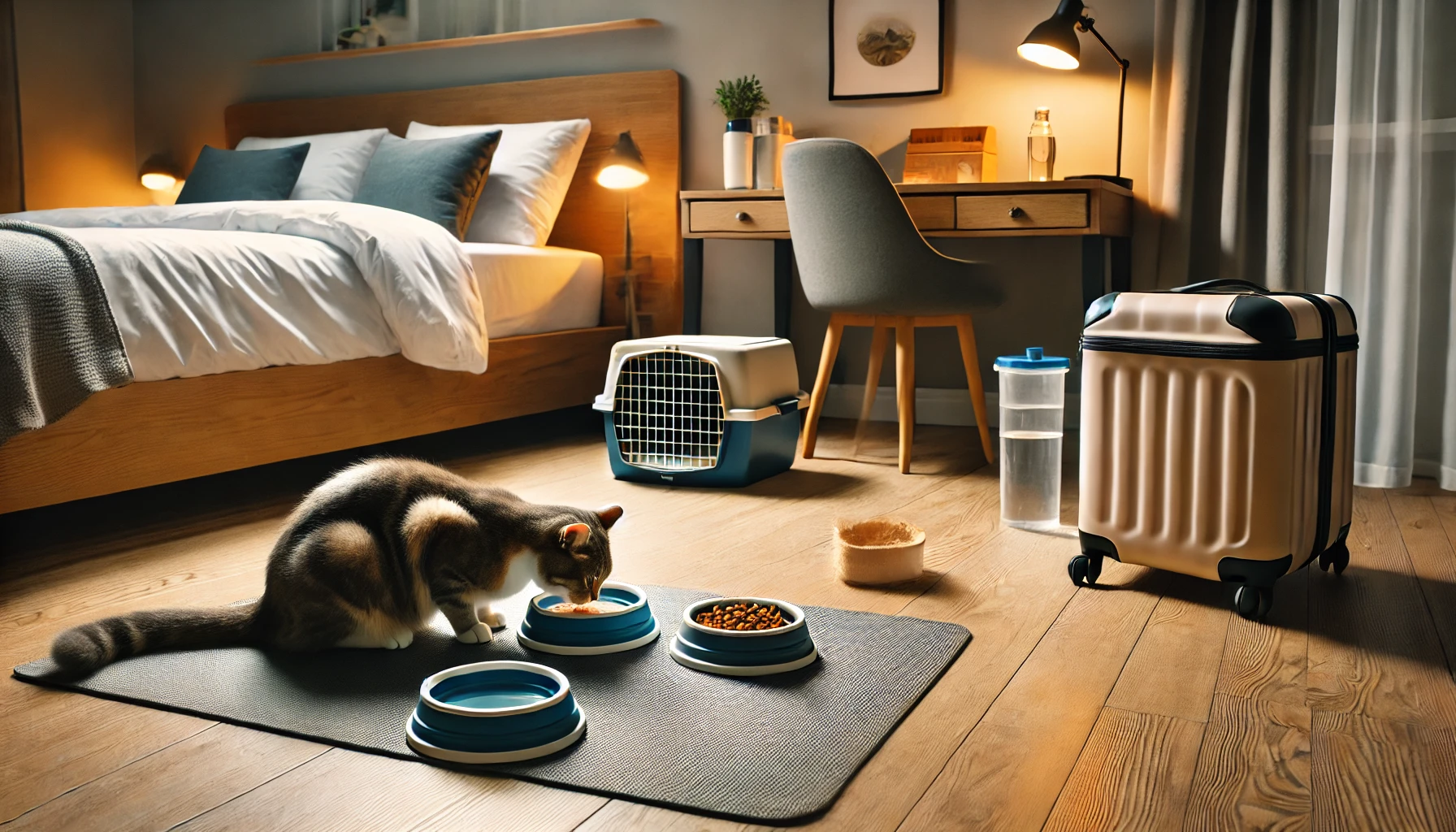
Keeping Your Cat Calm During Mealtimes in New Environments
Anxiety in new environments can make cats reluctant to eat.
Create a quiet, comfortable space for your cat to eat without distractions.
Using a familiar feeding mat or bowl can help reduce their stress and encourage them to eat.
Stick to your cat’s regular feeding times as much as possible and give them plenty of time to eat without rushing.
If your cat is especially stressed, try feeding them in their carrier or another safe space where they feel secure.
Reducing stress during meals will make the entire travel experience easier for both you and your cat.
Dealing with picky eaters or missed meals during travel requires patience. Try offering familiar food and keeping mealtimes consistent.
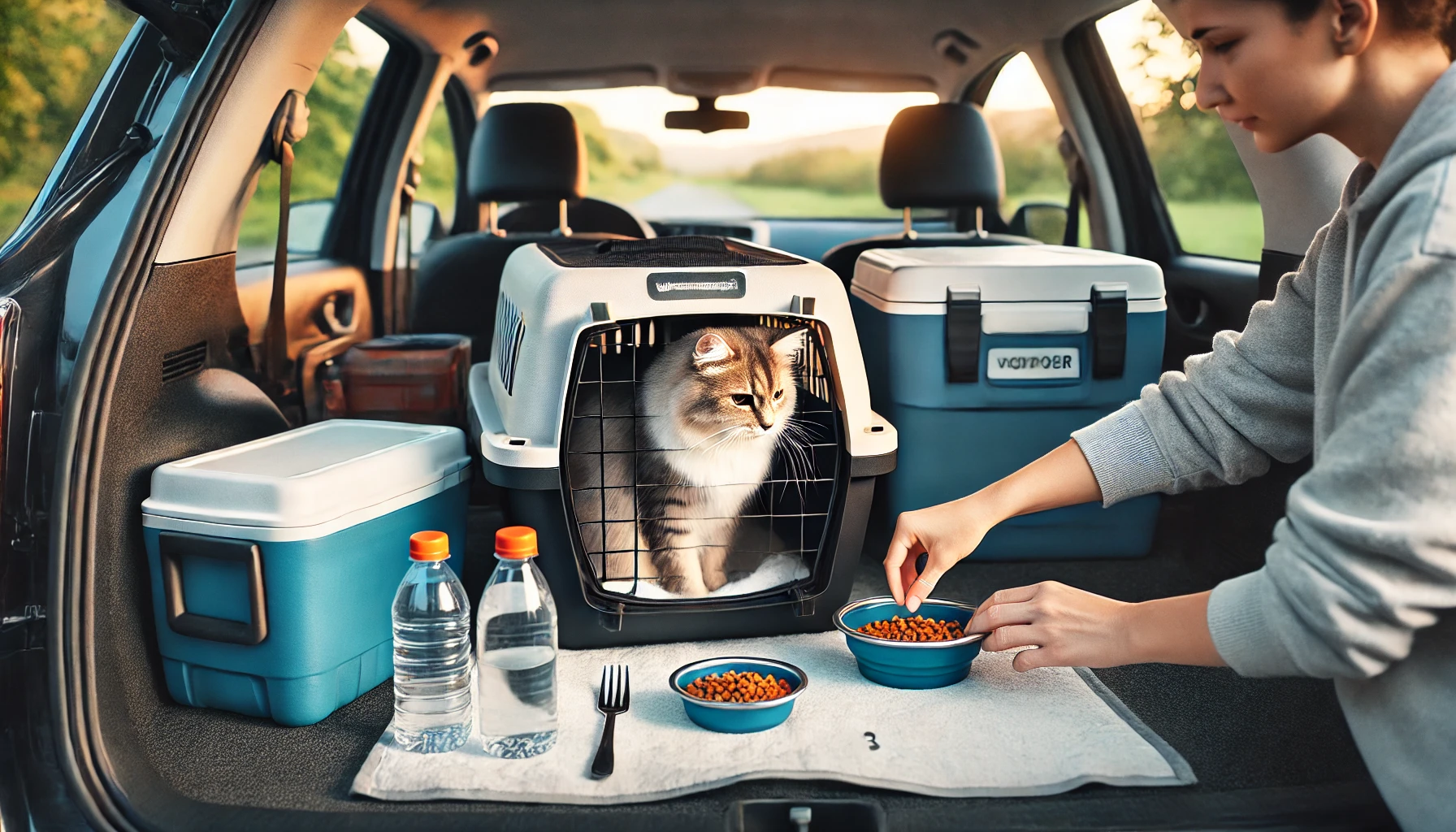
Overview: How to Maintain a Feeding Schedule for a Cat on the Road
Traveling with your feline friend can sometimes be overwhelming, especially when it comes to maintaining their feeding schedules.
Cats are creatures of habit and can become stressed by sudden changes in their feeding routines.
However, with proper planning and preparation, you can ensure that your cat remains healthy, hydrated, and comfortable throughout your journey.
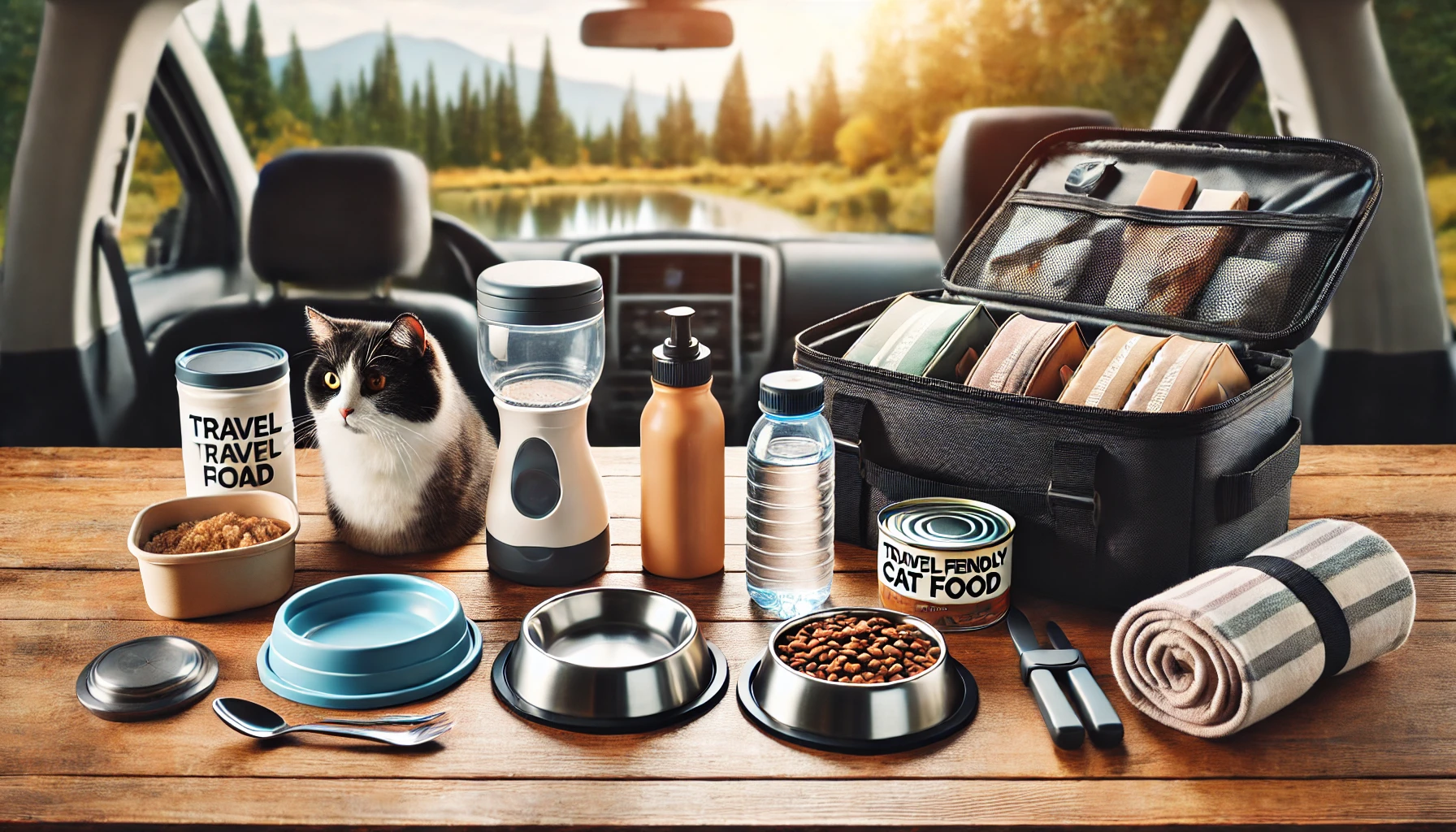
Key Takeaways for Managing Feeding Schedules
Here are some important tips to follow when taking care of your cat’s feeding schedule on the road:
- Stick to familiar food: A change in your cat’s food, combined with being on the road, can cause gastrointestinal problems and a loss of appetite.
- Gradually change feeding times: If you are traveling across time zones, gradually adjust feeding times by 15 to 30 minutes each day to help your cat adapt to a new schedule without stress.
- Bring enough food and water: Always bring extra food and water from home to ensure your cat has familiar sources of nutrition and hydration.
- Use automatic feeders: For extended journeys, utilize automatic feeders and other gadgets to help maintain a consistent feeding schedule.
- Keep your cat relaxed during meals: Create a quiet, distraction-free space for your cat to eat, and bring familiar items such as their regular bowl or feeding mat to make the experience more comfortable.
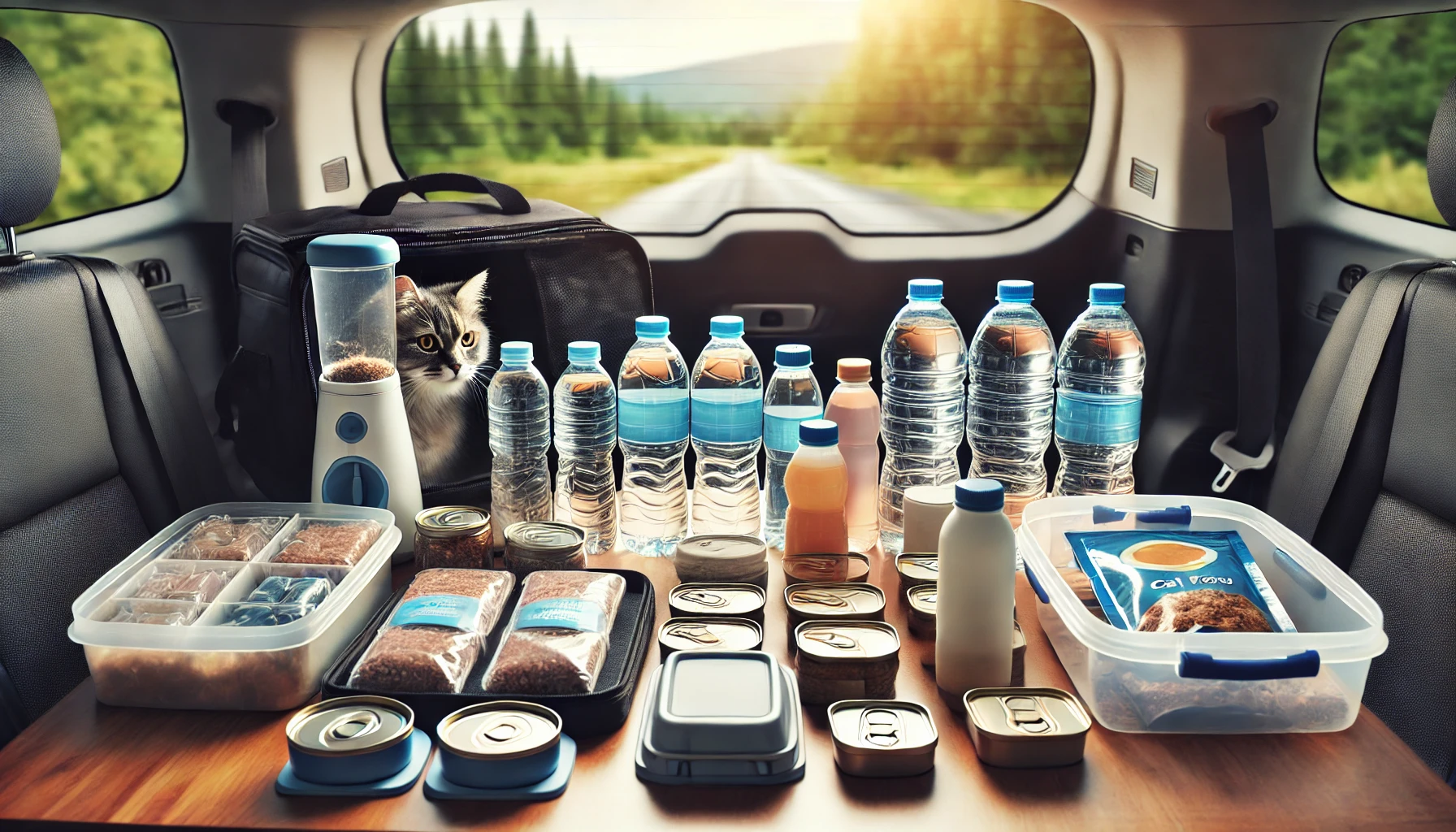
Preparing for Water and Nutrition Challenges
Hydration is just as important as maintaining a proper feeding schedule.
Since cats get a significant amount of moisture from their food, it’s essential to provide extra water, especially if they are eating dry food during travel.
Bring fresh water from home and use portable water dispensers to ensure your cat stays well-hydrated throughout the journey.
Offering smaller, more frequent meals or adding appealing flavors to their food can encourage picky eaters to eat while on the road.
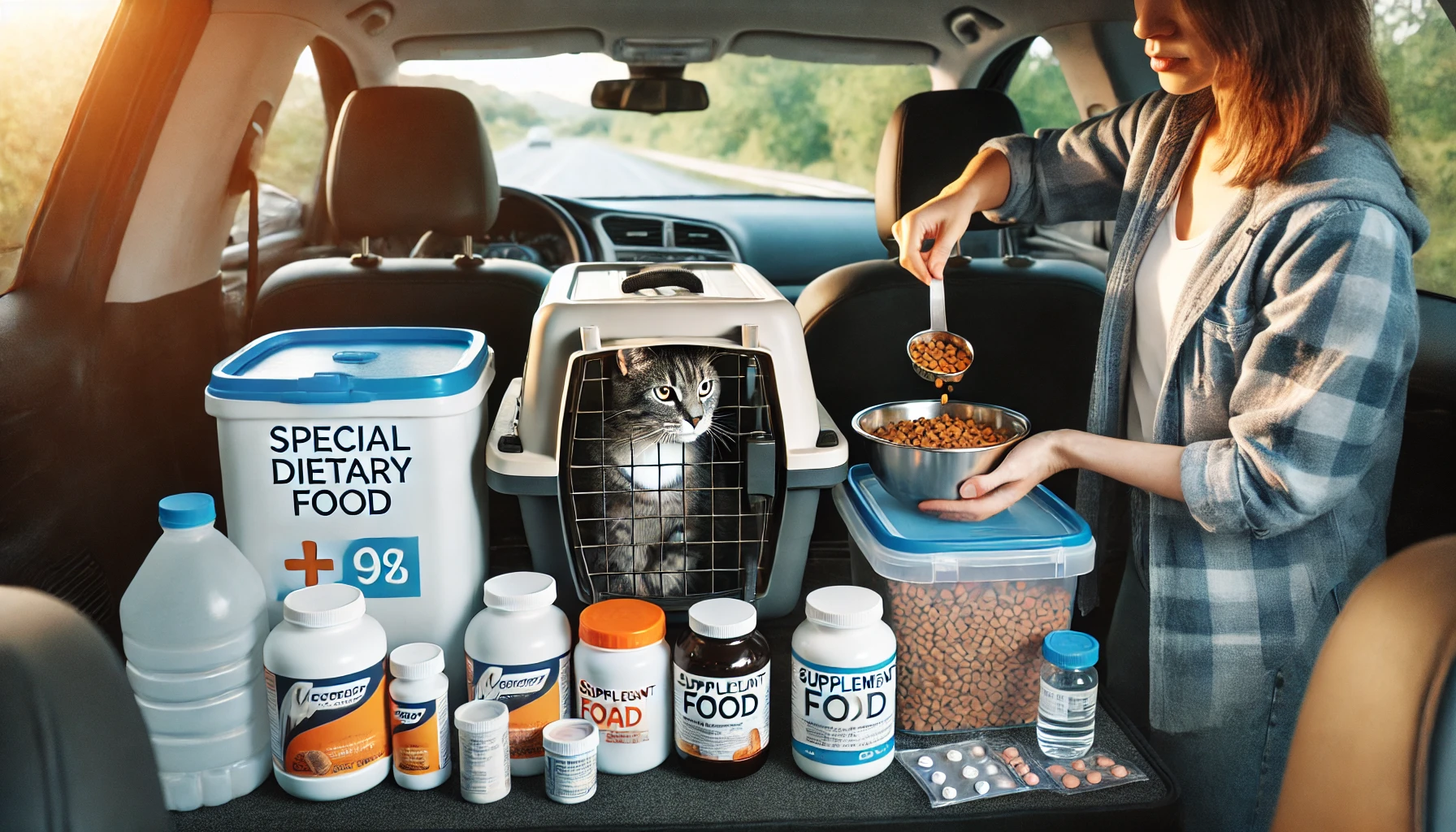
Special Considerations for Cats with Dietary Needs
If your cat has special dietary needs, make sure to pack enough prescription or specialty food to last the entire trip.
It can be difficult to find specific foods while traveling, so being prepared in advance will help.
Carry a copy of your cat’s dietary or medical information in case of emergencies, and don’t forget to pack any necessary supplements or medications.
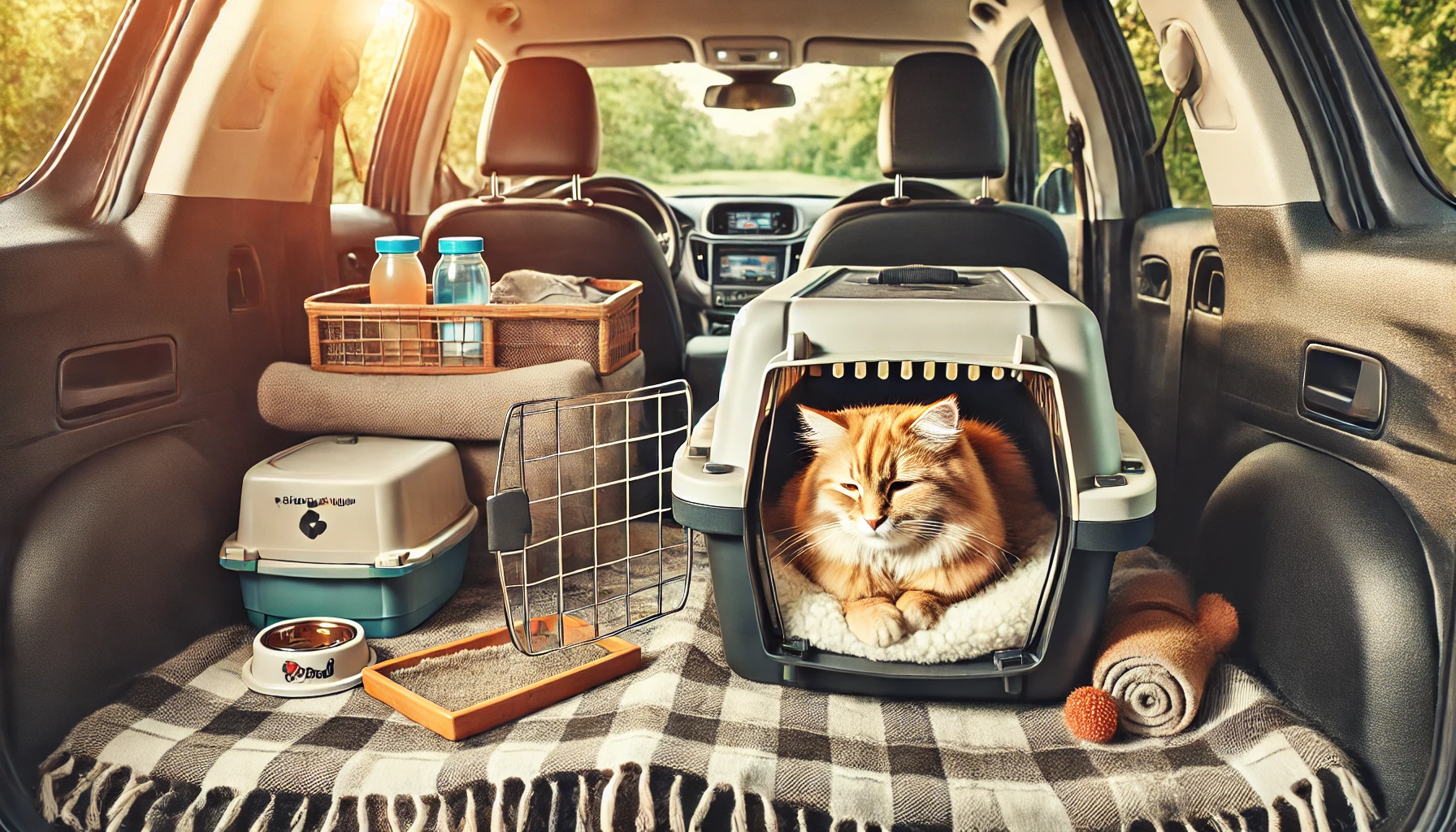
Making Travel Comfortable for Your Cat
Ultimately, the more comfortable and relaxed your cat is during the trip, the more likely they are to stick to their feeding and hydration schedule.
Reducing stress with familiar feeding routines, a comfortable environment, and proper planning will keep your cat healthy, happy, and well-nourished throughout the journey.
With the right strategies in place, you and your cat can enjoy a smooth, stress-free travel experience.
By keeping routines familiar and offering water frequently, you can help your cat adjust to traveling and maintain a healthy feeding schedule.
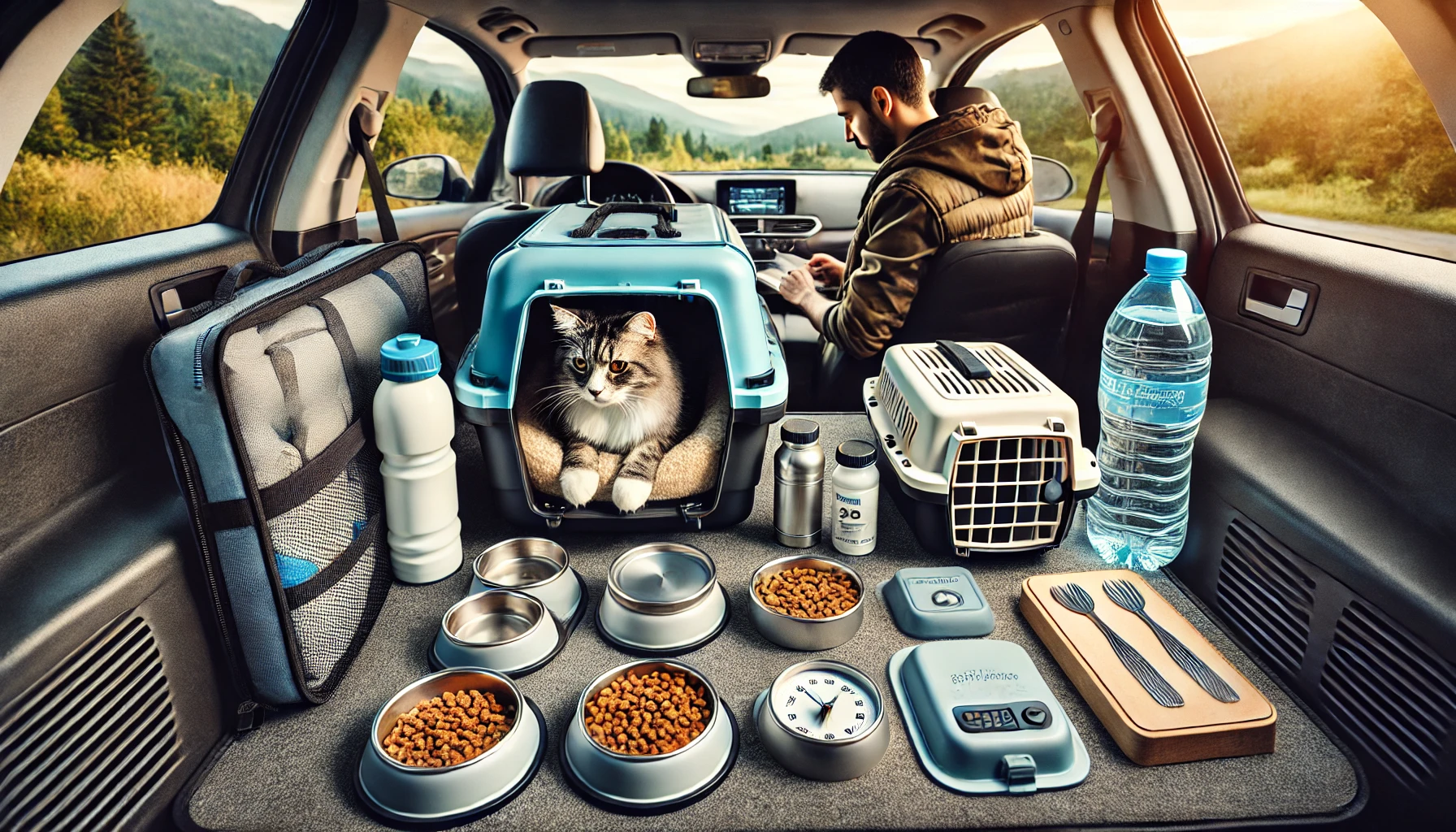
Frequently Asked Questions on Managing Road Cat Feeding Schedules
Traveling with cats can raise many concerns, especially regarding their feeding schedules.
Below are some of the most frequently asked questions to help ensure a smooth journey for you and your feline companion.
How do I get my cat to stick to their feeding schedule while traveling?
If traveling through time zones, gradually adjust feeding times before your trip.
Stick to familiar food and use automatic feeders or smart devices to keep the routine consistent and your cat comfortable and stress-free.
What type of food should I take for my cat while traveling?
Bring your cat’s usual food to avoid gastrointestinal issues.
Dry food is easier to store, but if your cat prefers wet food, use small cans or pouches.
Pack enough for the trip plus extra meals.
How do I keep my cat hydrated while traveling?
Bring fresh water from home to avoid unfamiliar tastes.
Use portable water dispensers and offer water frequently, especially if feeding dry food.
Hydration is critical for maintaining your cat’s health during travel.
What if my cat refuses to eat on the road?
Encourage your cat to eat by offering smaller, more frequent meals and by adding favorite treats or tuna juice to their regular food.
If your cat doesn’t eat for 24-48 hours, consult a veterinarian immediately.


